Check out our range of stock.
Didn't find what you like?
Send us a message
Found something out of stock?
Send us a message
![5BT32 - [ARRIVED 2 - JUL - 2025] Red Dragon Halfmoon Plakat Betta Male - Nano Tanks Australia](http://nanotanksaustralia.com.au/cdn/shop/files/5bt32-arrived-2-jul-2025-red-dragon-halfmoon-plakat-betta-male-6345770.jpg?v=1751530418&width=645)
Discover this rare betta fish for sale in Australia, exactly as shown in the photos. Each fish is healthy, vibrant, and full of personality—making it the perfect addition to your aquarium. Shipped safely from Sydney, our bettas are ready to thrive in your home tank. Specifications: Males: Approx. 4–5 cm | Giant bettas: 7–9 cm Females: Approx. 3–4 cm | Giant bettas: 7–9 cm Age: 3–6 months Origin: Imported from Indonesia or Thailand Important Notes: Koi, grizzle, and fancy bettas may naturally change colour and pattern as they grow or during transit. Long-fin varieties may occasionally nip their own tails—this is a natural behaviour. All fish are kept in Sydney tap water (23–26°C, pH ~7) to ensure they’re well-adjusted and healthy. Shipping: We ship live bettas from Sydney every Monday and Tuesday for the safest transit. Please see our Shipping Policy for more details. Optional Video:Want a closer look at your betta before purchase? Order a video of your exact fish through the link provided.
$59.00
![5BT44 - [ARRIVED 2 - JUL - 2025] Blue Rim Fancy Betta Male - Nano Tanks Australia](http://nanotanksaustralia.com.au/cdn/shop/files/5bt44-arrived-2-jul-2025-blue-rim-fancy-betta-male-8369383.jpg?v=1751530417&width=645)
Discover this rare betta fish for sale in Australia, exactly as shown in the photos. Each fish is healthy, vibrant, and full of personality—making it the perfect addition to your aquarium. Shipped safely from Sydney, our bettas are ready to thrive in your home tank. Specifications: Males: Approx. 4–5 cm | Giant bettas: 7–9 cm Females: Approx. 3–4 cm | Giant bettas: 7–9 cm Age: 3–6 months Origin: Imported from Indonesia or Thailand Important Notes: Koi, grizzle, and fancy bettas may naturally change colour and pattern as they grow or during transit. Long-fin varieties may occasionally nip their own tails—this is a natural behaviour. All fish are kept in Sydney tap water (23–26°C, pH ~7) to ensure they’re well-adjusted and healthy. Shipping: We ship live bettas from Sydney every Monday and Tuesday for the safest transit. Please see our Shipping Policy for more details. Optional Video:Want a closer look at your betta before purchase? Order a video of your exact fish through the link provided.
$59.00

This stunning Black Metal Snakeskin Guppy is a rare and highly sought-after fish for collectors and enthusiasts. Its unique black and metallic pattern make it a standout in any aquarium, adding a touch of elegance and sophistication. These guppies are sold as pairs, making them the perfect addition to your tank. Characteristics Family Poeciliidae Origin Native to South America, pet fish are captive-bred Social Peaceful Tank Level Top, mid-dweller Minimum Tank Size 10 gallon Diet Omnivore Breeding Live-bearer Care Beginner pH 6.5 to 8.0 Hardness 100 to 150 mg/L (6 to 8 dH) Temperature 68 to 78 F (20 to 26 C) Origin and Distribution The guppy has been captive bred for over 100 years, but originally came from South America. They are named for Robert John Lechmere Guppy who collected these fish on the island of Trinidad in 1866. They are native to freshwater streams in the north of South America, including Surinam, Guyana, and Venezuela, and the Caribbean islands, including Barbados and Trinidad and Tobago. Now, they have been introduced to every continent but Antarctica, and can be found in many warm waterways around the world. Tankmates Guppies are peaceful, easygoing community fish that play well with a mix of other non-aggressive fish species. You may want to keep them with similar, live-bearing fish, such as platys or mollies. Other good tankmates include small fish, such as neon tetras or zebrafish. Keep in mind that any fry spawned from an active guppy female may be dinner for other fish in the tank, so having smaller tankmates will ensure more fry survive. Many guppy keepers often opt for a guppy-only aquarium. You are welcome to mix different varieties of guppy in the same tank. The number of guppies you can keep in one tank will depend on the size of the tank—a general guideline is 1 gallon of water for every 1 inch of fish. For example, because guppies average around 2 inches in length, a 10-gallon tank may only hold five guppies comfortably, while a 30-gallon tank may hold 15 guppies. Generally, it’s also best to have two or three females for every one male in the tank. Guppy Habitat and Care Guppies are great beginner fish. They are low maintenance and can tolerate some beginner mistakes. A bigger tank size is recommended since guppies are very active fish. They thrive in an aquarium with plants and soft décor items. In order to keep your population from exploding, it is strongly recommended that you separate males and females in different tanks. Guppy females can store sperm for multiple spawns, even after separation from males, so once a female has been with a male, she may have multiple batches of babies. Tank dividers are okay as a temporary solution, but many of these flimsy, plastic dividers are usually not enough to keep fish separated. Two separate tanks will keep unwanted spawning to zero. Heater As a general rule, you need a heater to keep your guppies healthy. They prefer water temperatures in the 70s, and few homes are warm enough to provide that without an immersible heater in the tank. Monitor water temperature daily and adjust the heater as needed to keep your fish comfortable and healthy. Filtration Your aquarium definitely needs a filter to remove impurities and harmful chemicals from the tank water. Without a filter, aquarium water tends to quickly become filled with pollutants from uneaten food and fish waste, and your fish can become ill or even die from this harmful water. There are many types of aquarium filters available to suit any budget, so talk to the fish expert at your local aquarium shop or pet store if you are uncertain as to which filter is best for your tank. Guppy Diet and Feeding Guppies are omnivores and do well on a variety of commercially available feeds. Even though guppies are small in size, pelleted diets called micro pellets are the best choice since they hold onto their nutrition longer than flakes. You are welcome to add supplements, such as frozen fish foods, but no more than once or twice a week. The complete pelleted diet is best for most pet fish species. Depending on your aquarium's temperature and the other tank inhabitants, you may feed your fish once or twice a day. Always start with a little bit of food, and when it has all been consumed, add a little more. Repeat for a few minutes and use this time to check all of your fish. Feeding time is a great time to see if any of your fish are acting odd or sick. Gender Differences There are a few gender differences you will need to identify to keep your male and female populations separate. Males tend to be smaller and more vibrantly colored. Females tend to have a brown coloration and are larger and rounder. Also, as male guppies grow, their body will develop coloration that does not occur on the female's body. On the underside of the fish, the anal fin of the male is long and thin and tapers to a point. The anal fin on the female guppy is larger and triangular or fan in shape. Guppies are sexually mature in about two to three months, and you should be able to identify the differences between genders by 1 month of age, if you wish to separate them. Female guppies first produce offspring at 10–20 weeks of age, and they continue to reproduce until 20–34 months of age. Breeding the Guppy Many beginner hobbyists will start with only one female guppy and suddenly have a swarm. Since female guppies can store sperm, it only takes one insemination by a male for a few spawns to be born. In order to prevent your aquarium from maxing out its stocking capacity, it is always best to separate male and female guppies. Guppies are live-bearers, so the female will give birth to 10–50 wiggling fry per spawning. Many times, the newly born fry will be eaten by other fish in the aquarium, so if you want to save any fish, keep them in a separate tank or breeding box. Heavily planted aquariums will also give the babies places to hide and survive. After breeding together many generations of the same population, you may notice an increased number of fish with congenital abnormalities, such as crooked spines or shortened lifespans.
$30.00
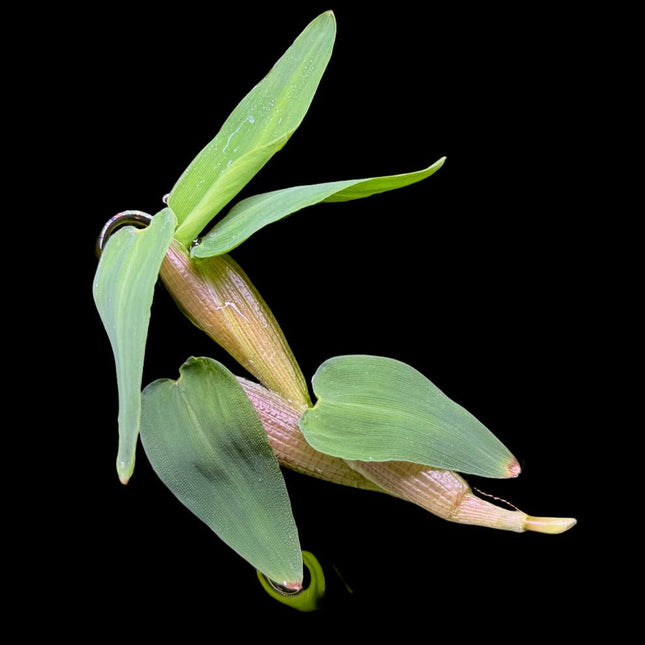
Hygroryza aristata is a unique floating aquatic plant in the Poaceae family. This species is known for its attractive appearance and ability to create a lush, green canopy on the water's surface. Its floating nature and distinctive foliage make it a fascinating addition to any aquarium, providing both aesthetic appeal and functional benefits such as shading and habitat for aquatic life. Key Features: Scientific Name: Hygroryza aristata Common Name: None Family Name: Poaceae Water Parameters: Temperature: 22°C - 28°C pH: 6.0 - 7.5 Hardness: Soft to moderately hard water Light Requirement: Moderate to high lighting Bright light promotes vigorous growth CO2 Requirements: Not necessary Can thrive without CO2 supplementation Plant Appearance: Leaves: Narrow, elongated leaves that float on the water surface, forming dense mats. Growth Habit: Floating stems that spread across the water, providing cover and reducing algae growth by blocking light. Size: Can cover large areas of the water surface, suitable for tanks of various sizes. Care Tips: Regular trimming helps manage its spread and keeps the plant from overcrowding the tank. Thrives in nutrient-rich water, benefiting from regular fertilization. Ideal for providing shade and creating hiding spots for fish and invertebrates. Hygroryza aristata is an exceptional choice for aquarists seeking to add a unique, floating plant to their aquariums. Its ease of care and ecological benefits make it a valuable addition to any aquatic environment. Please note that depending on the season the look of this plant will vary
$8.00
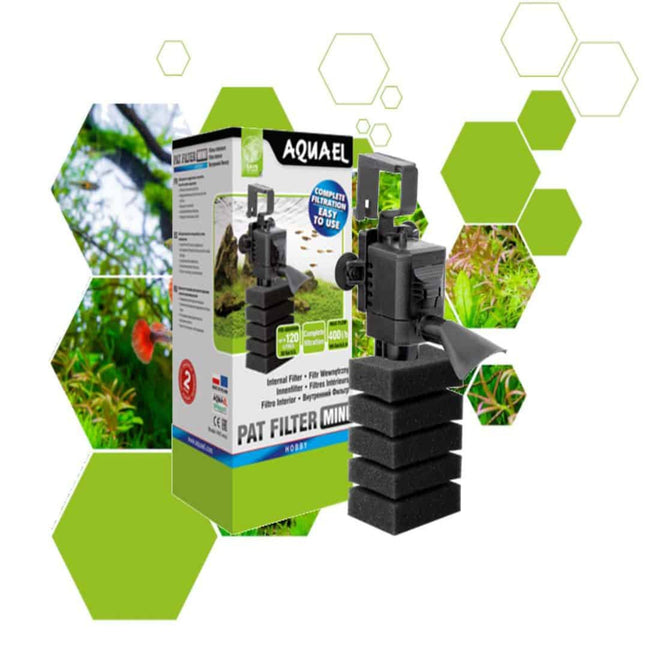
AQUAEL PAT MINI is a tiny turbine filter intended for use in small freshwater aquariums. This device consists of a small head and a carefully selected filter sponge. Thanks to the innovative design, the maximum throughput of the filter head reaches 400 l/h, which is comparable to the typical performance of a medium-sized turbine aquarium filter. Despite its high performance, the filter operates at a power consumption of 4W or less. Given its specifications, PAT MINI can provide efficient filtration even in a 120-liter tank. However, you should not be concerned about the filter creating an excessive whirling motion in smaller tanks, since there is a performance control switch in the front part of the head that allows you to adjust throughput as required. In addition, the filter is equipped with a directional nozzle that can be used to control the outflow of water into the tank e.g. by directing it towards a tank wall. The aeration tube connected to the outlet nozzle ensures efficient oxygenation of the water. The sponge supplied with the PAT MINI filter can trap even the finest visible impurities, performing efficient mechanical filtration of water in the tank. In addition, the sponge provides an ideal living environment for strains of beneficial nitrifying bacteria that oxidize ammonia and nitrates, toxic substances that are harmful to fish. Maintenance of the sponge is very simple and takes less than a minute. Regular maintenance will guarantee continuous operation of the filter, and the inhabitants of our aquarium will swim in crystal-clear and toxin-free water. The device is very easy to install thanks to a holder equipped with strong suction cups and a functional bracket that can be used to hook the filter onto the edge of a tank wall. The PAT MINI filter is compatible with the AQUAEL sprinkler and the AQUAEL MINI UV water sterilizer. Replacement sponge media can be purchased separately. They are available either in the standard version or in the CARBOMAX and PHOSMAX versions. The CARBOMAX sponge is saturated with activated carbon to remove chemical contaminants and water discoloration. The PHOSMAX sponge is intended for removing phosphates from the water in order to prevent the growth of algae. DO YOU NEED PARTS? IF YOU DO PLEASE CONTACT US AND WE CAN ARRANGE THE PARTS FOR YOU.
$59.00
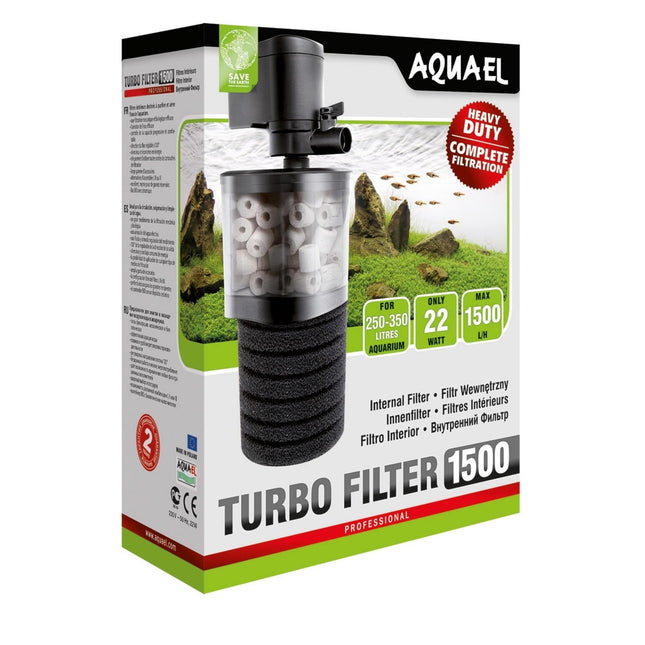
AQUAEL TURBO FILTER is designed for the cleaning and aeration of aquarium water. This quiet and energy-efficient filter provides double (mechanical and biological) filtration out of the box. It is compatible with any biological or chemical filter cartridges offered by AQUAEL, such as BioCeraMAX Pro 600, BioCeraMAX Pro 1200, BioCeraMAX Pro 1600, ZeoMAX PLUS, CarboMAX PLUS, NitroMAX PRO, PhosMAX BASIC, and PhosMAX PRO. The sealed rotor chamber ensures high efficiency at a relatively low level of power consumption. All the AQUAEL TURBO FILTER models are equipped with special shock-absorbing suction cups to dampen vibrations that may be carried to the glass and to muffle the operation of the device. The larger models, TURBO FILTER 1000, 1500, and 2000, are equipped with a ceramic rotor axis for even quieter operation and enhanced durability. Thanks to the special design of AQUAEL TURBO internal filters, they are easily expandable. The filter media containers can be filled with any filter medium, as required. The starter kit includes: a container for loose filter media with a capacity of 250 ml in the TURBO FILTER 500 model and 625 ml in the TURBO FILTER 1000, 1500, and 2000 models, one BioCeraMAX Pro 600 cartridge for biological filtration, one sponge of carefully selected density to ensure high filtering parameters for as long as possible TURBO filters are available in three installation configurations: sponge only, container only, container plus a sponge. Additional containers for filter media can be bought separately. You can easily join them in columns thanks to a specially designed connection system. In this way, the filter can be transformed into a customised device with unique filtration parameters, carefully tailored to individual needs.
$169.00
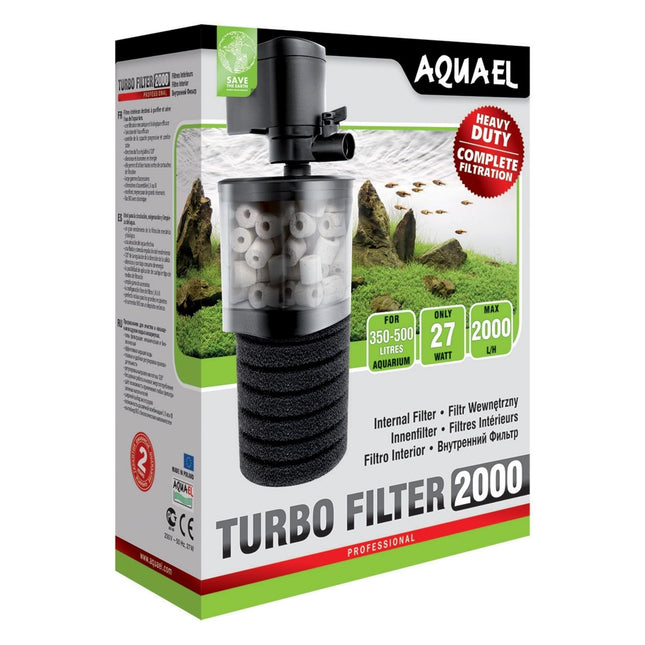
AQUAEL TURBO FILTER is designed for the cleaning and aeration of aquarium water. This quiet and energy-efficient filter provides double (mechanical and biological) filtration out of the box. It is compatible with any biological or chemical filter cartridges offered by AQUAEL, such as BioCeraMAX Pro 600, BioCeraMAX Pro 1200, BioCeraMAX Pro 1600, ZeoMAX PLUS, CarboMAX PLUS, NitroMAX PRO, PhosMAX BASIC, and PhosMAX PRO. The sealed rotor chamber ensures high efficiency at a relatively low level of power consumption. All the AQUAEL TURBO FILTER models are equipped with special shock-absorbing suction cups to dampen vibrations that may be carried to the glass and to muffle the operation of the device. The larger models, TURBO FILTER 1000, 1500, and 2000, are equipped with a ceramic rotor axis for even quieter operation and enhanced durability. Thanks to the special design of AQUAEL TURBO internal filters, they are easily expandable. The filter media containers can be filled with any filter medium, as required. The starter kit includes: a container for loose filter media with a capacity of 250 ml in the TURBO FILTER 500 model and 625 ml in the TURBO FILTER 1000, 1500, and 2000 models, one BioCeraMAX Pro 600 cartridge for biological filtration, one sponge of carefully selected density to ensure high filtering parameters for as long as possible TURBO filters are available in three installation configurations: sponge only, container only, container plus a sponge. Additional containers for filter media can be bought separately. You can easily join them in columns thanks to a specially designed connection system. In this way, the filter can be transformed into a customised device with unique filtration parameters, carefully tailored to individual needs.
$189.00
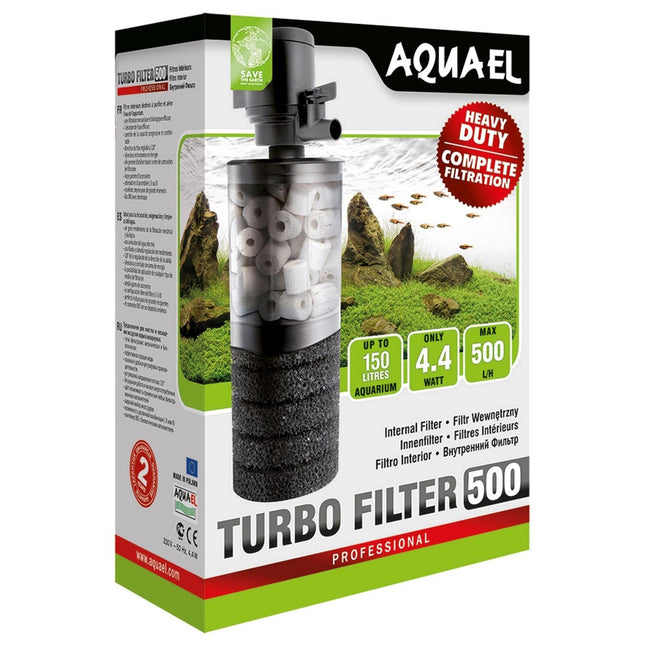
AQUAEL TURBO FILTER is designed for the cleaning and aeration of aquarium water. This quiet and energy-efficient filter provides double (mechanical and biological) filtration out of the box. It is compatible with any biological or chemical filter cartridges offered by AQUAEL, such as BioCeraMAX Pro 600, BioCeraMAX Pro 1200, BioCeraMAX Pro 1600, ZeoMAX PLUS, CarboMAX PLUS, NitroMAX PRO, PhosMAX BASIC, and PhosMAX PRO. The sealed rotor chamber ensures high efficiency at a relatively low level of power consumption. All the AQUAEL TURBO FILTER models are equipped with special shock-absorbing suction cups to dampen vibrations that may be carried to the glass and to muffle the operation of the device. The larger models, TURBO FILTER 1000, 1500, and 2000, are equipped with a ceramic rotor axis for even quieter operation and enhanced durability. Thanks to the special design of AQUAEL TURBO internal filters, they are easily expandable. The filter media containers can be filled with any filter medium, as required. The starter kit includes: a container for loose filter media with a capacity of 250 ml in the TURBO FILTER 500 model and 625 ml in the TURBO FILTER 1000, 1500, and 2000 models, one BioCeraMAX Pro 600 cartridge for biological filtration, one sponge of carefully selected density to ensure high filtering parameters for as long as possible TURBO filters are available in three installation configurations: sponge only, container only, container plus a sponge. Additional containers for filter media can be bought separately. You can easily join them in columns thanks to a specially designed connection system. In this way, the filter can be transformed into a customised device with unique filtration parameters, carefully tailored to individual needs.
$88.00
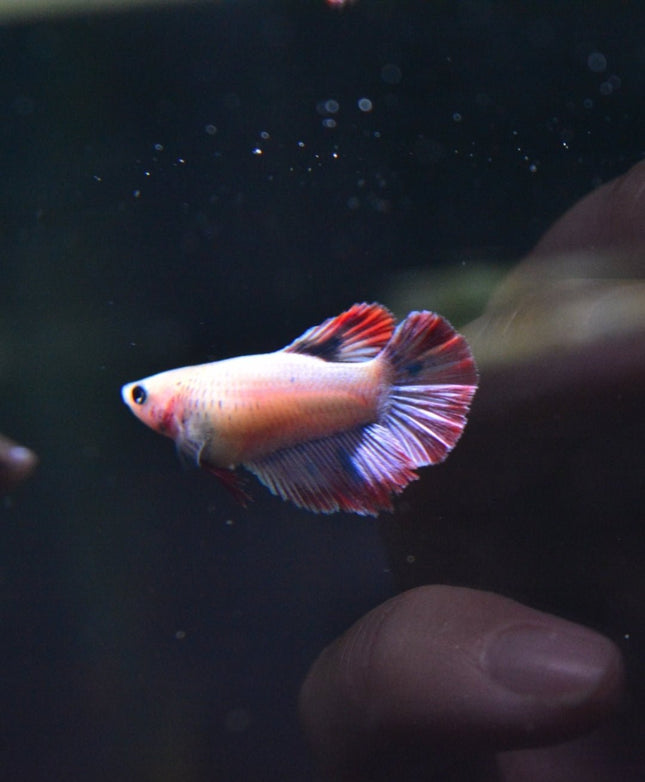
Assorted female bettas available will vary depending on stock. We normally have an assortment of colours and include a variety of strains such as veil tail, Halfmoon, Plakats, Dumbos, Double tails, etc.
$20.00
![[ARRIVED 20 - JUN - 2025] Echinodorus Martii bareroot - Nano Tanks Australia](http://nanotanksaustralia.com.au/cdn/shop/files/arrived-20-jun-2025-echinodorus-martii-bareroot-782598.jpg?v=1750749841&width=645)
Description:Echinodorus Martii, commonly known as the Ruffle Sword Plant, is a striking aquatic species prized for its long, wavy-edged leaves that create a dramatic, textured appearance in aquariums. Its bright green, ruffled foliage adds visual interest and serves as an excellent midground to background plant, particularly in larger tanks where it can grow up to 12–24 inches (30–60 cm) tall 147. Key Features: Leaf Structure: Long, thick leaves with ruffled margins and light striations, providing a lush, natural look 14. Growth Habit: Forms a rosette and can produce adventitious shoots (side runners) for propagation 15. Color & Contrast: Its vibrant green hue pairs well with red plants, enhancing aquascape aesthetics 18. Care Requirements: Lighting: Thrives in moderate to high light but adapts to lower light with slower growth 17. Substrate: Requires a nutrient-rich substrate (e.g., enriched soil or root tabs) as it is a heavy root feeder 1411. CO2 & Fertilization: CO2 is optional but boosts growth; benefits from iron and trace elements 47. Water Parameters: Prefers 72–84°F (22–30°C), pH 5.0–7.5, and soft to moderately hard water 711. Propagation & Maintenance: Propagates via side shoots or rhizome division 47. Prune older leaves to control size and encourage new growth 15. Ideal For: Beginners due to its hardiness 13. Centerpiece or background in mid-to-large tanks 28. Origin: Native to Central and South America, often found in submerged riverbanks 15. Note: Some taxonomists classify E. martii as synonymous with E. major or E. subalatus, but it remains a trade staple under its common name 5.
$20.00
![[ARRIVED 20 - JUN - 2025] Seachem Prime 100ml - Nano Tanks Australia](http://nanotanksaustralia.com.au/cdn/shop/files/arrived-20-jun-2025-seachem-prime-100ml-363120.png?v=1750390023&width=645)
Overview Nearly all pet aquatics companies manufacture a product that removes chlorine. None of those, however, can compare in quality, concentration, or effectiveness to Seachem’s flagship product: Prime®. Prime® is the complete and concentrated conditioner for both fresh and saltwater. Prime® removes chlorine, chloramine and detoxifies ammonia, nitrite, and nitrate. It is non-acidic and will not impact pH. A further bonus for the reef hobbyist—Prime® will not over-activate skimmers. Prime® is up to 5x more concentrated than competing products and is the second most concentrated dechlorinator on the market only after our own aquavitro® alpha™. Prime® may be used during tank cycling to alleviate ammonia/nitrite toxicity. It contains a binder which renders ammonia, nitrite, and nitrate non-toxic, allowing the biofilter to more efficiently remove them. It will also detoxify any heavy metals found in the tap water at typical concentration levels. Use at start-up and whenever adding or replacing water. When transporting or quarantining fish, use Seachem StressGuard™. When adding new fish, use Stability®. Both are ideal for use with Prime®. Directions Use 1 capful (5 mL) for each 200 L (50 US gallons) of new water. For smaller volumes, please note each cap thread is approximately 1 mL. May be added to aquarium directly, but better if added to new water first. If adding directly to aquarium, base dose on aquarium volume. Sulfur odor is normal. For exceptionally high chloramine concentrations, a double dose may be used safely. To detoxify nitrite in an emergency, up to 5 times normal dose may be used. If temperature is > 30 °C (86 °F) and chlorine or ammonia levels are low, use a half dose. FAQ I think that my Prime® might be old because it smells like it went bad. A: Prime® has a very distinct odor that is similar to sulfur which is completely normal. I noticed some small black specks in the bottom of my bottle of Prime®. Is it still good? A: The presence of small black specks occasionally occurs and is normal. I am using Prime® to control ammonia but my test kit says it is not doing anything, in fact it looks like it added ammonia! What is going on? A: A Nessler based kit will not read ammonia properly if you are using Prime®... it will look "off scale", sort of a muddy brown (incidentally a Nessler kit will not work with any other products similar to Prime®). A salicylate based kit can be used, but with caution. Under the conditions of a salicylate kit the ammonia-Prime® complex will be broken down eventually giving a false reading of ammonia (same as with other products like Prime®), so the key with a salicylate kit is to take the reading right away. However, the best solution ;-) is to use our MultiTest™ Ammonia kit; it uses a gas exchange sensor system which is not affected by the presence of Prime® or other similar products. It also has the added advantage that it can detect the more dangerous free ammonia and distinguish it from total ammonia (total ammonia is both free ammonia and non-toxic ionized forms of ammonia). I tested my tap water after using Prime® and came up with an ammonia reading. Is this because of chloramine? Could you explain how this works in removing chloramine? A: Prime® works by removing chlorine from the water and then binds with ammonia until it can be consumed by your biological filtration (chloramine minus chlorine = ammonia). The bond is not reversible and ammonia is still available for your bacteria to consume. Prime® will not halt your cycling process. I am going to assume that you were using a liquid based reagent test kit (Nessler based, silica). Any type of reducing agent or ammonia binder (dechlorinators, etc) will give you a false positive. You can avoid this by using our MultiTest™ Ammonia kit (not affected by reducing agents) or you can wait to test, Prime® dissipates from your system within 24 hours. How does Prime® make a difference in reducing nitrates? A: The detoxification of nitrite and nitrate by Prime® (when used at elevated levels) is not well understood from a mechanistic standpoint. The most likely explanation is that the nitrite and nitrate is removed in a manner similar to the way ammonia is removed; i.e. it is bound and held in a inert state until such time that bacteria in the biological filter are able to take a hold of it, break it apart and use it. Two other possible scenarios are reduction to nitrogen (N2) gas or conversion into a benign organic nitrogen compound. I wish we had some more "concrete" explanation, but the end result is the same, it does actually detoxify nitrite and nitrate. This was unexpected chemically and thus initially we were not even aware of this, however we received numerous reports from customers stating that when they overdosed with Prime® they were able to reduce or eliminate the high death rates they experienced when their nitrite and nitrate levels were high. We have received enough reports to date to ensure that this is no fluke and is in fact a verifiable function of the product. How often can I dose Prime®? A: Prime® can be dosed every 24-48 hours. If Prime® is removing ammonia from the system, won’t that starve the beneficial bacteria? A: Prime® does not remove ammonia, nitrite, or nitrate from the system. It simply binds with those compounds making them harmless to the inhabitants and still bioavailable to the beneficial bacteria. How long does Prime® stay bound to the ammonia, nitrite, and nitrates? A: Prime® will bind up those compounds for up to 48 hours. If they are still present after that time frame, they are released back into the water, unless Prime® is re-dosed accordingly. Also, if your ammonia or nitrite levels are increasing within a 24-hour period, Prime® can be re-dosed every 24 hours. When should I use the emergency dose of 5 x the recommended amount of Prime®? A: If your ammonia or nitrite levels are above 2 ppm, you can safely use up to 5 x the recommended amount. Does Prime® expire? A: No, as long as Prime® has been stored properly, it will last indefinitely. My Prime® smells like garlic. Is this normal? A: Prime® can vary in smell based on the parameters in the warehouse during the time of manufacture. It does normally smell of Sulfur, but we have extensively tested the product and found that the difference in scent does not in any way effect how the product functions. It is still perfectly safe to use!
$12.00
![[ARRIVED 20 - JUN - 2025] Seachem Stability 100ml - Nano Tanks Australia](http://nanotanksaustralia.com.au/cdn/shop/files/arrived-20-jun-2025-seachem-stability-100ml-110434.png?v=1750389930&width=645)
Overview Stability® will rapidly and safely establish the aquarium biofilter in freshwater and marine systems, thereby preventing the #1 cause of fish death: "new tank syndrome". Stability® is formulated specifically for the aquarium and contains a synergistic blend of aerobic, anaerobic, and facultative bacteria which facilitate the breakdown of waste organics, ammonia, nitrite, and nitrate. The bacteria employed by Stability® are non-sulfur fixing and will not produce toxic hydrogen sulfide. Stability® is completely harmless to all aquatic organisms as well as aquatic plants, thus there is no danger of over use. Stability® is the culmination of nearly a decade of research and development and represents the current state of the art in natural biological management. The bacteria used in competing products are inherently unstable. The conditions necessary for their growth and development fall into a very narrow range of temperatures, pH, organic loads, etc. When any of these parameters are not strictly within the proper range, the bacterial culture quickly crashes and dies. Stability® is not limited this way. The necessary conditions for the growth of Stability's™ bacteria strains encompass a very broad range. When other bacteria begin to die off (usually from high organic loads caused by the undetected death of an organism), Stability™ simply becomes more effective. Directions Shake well before use. Turn off UV/ozone. Use 1 capful (5 mL) for each 40 L (10 US gallons) on the first day with a new aquarium. Then use 1 capful for each 80 L (20 US gallons) daily for 7 days. Fish and other aquatic species may be introduced at any time as long as dosage is maintained for 7 days. For optimum biofilter performance use 1 capful for each 80 L (20 US gallons) once a month or with each water change and whenever introducing new fish or whenever medicating an aquarium. Product shelf life is 6 years from date of manufacture. Stability® should ideally be used in conjunction with biological filtration such as Seachem Matrix™. For emergency ammonia control, use Seachem AmGuard™. FAQ When dosing Stability™, how long should I turn off my UV filter or my ozone? A: The UV and/or ozone should be kept off for the 7 days you are dosing if you are cycling or for at least 24 hours if it is for Stability™ additions of new fish or water changes. The reason both should be turned off is because UV and ozone break down and kill bacteria. What is a reasonable amount of time to allow the Stability™ to come out of the spore state and find a home to attach themselves? A: The bacteria should be able to find a suitable home within 24 hours. I just finished cycling my new tank, but i made a mistake of introducing many fishes at the same time. i was wondering if i could use Stability™ to increase the bb's for the increased bioload? A: Yes, Stability™ will prove very helpful in removing ammonia and nitrite, including nitrate, as a result of the increased bioload. If your ammonia level is not at zero, a combination of Stability™ and AmGuard is very useful and great in reducing ammonia toxicity on the bacteria blend as the bacteria consumes the ammonia, nitrite and nitrate in the aquarium Why does Stability™ not need refrigeration? If there's living bacteria in the solution, how do they stay alive for so long? Or is there something else besides bacteria in the product altogether? A: The bacteria in Stability™ are alive but not active. They exist in a spore form. They can withstand extreme temperatures and do not require food to survive. When you add them to your aquarium they become active due to dilution. The bacteria that require refrigeration are active. Refrigerating them slows down their life cycle and they require less food when cold. Because they are active they do require food, and that is packaged with them. They also will not survive extreme heat or cold and will die when they run out of food. Can Stability™ be overdosed? A: It is very hard to overdose Stability. You can really never have too much beneficial bacteria. The worst thing that could happen is a bacterial bloom in the water column, but this is rare and will clear on its own, should it occur. I have finished the suggested 7-day dosing, however, my tank is still not fully cycled. Why? A: Since every tank will cycle differently, it is difficult for us to give an exact time frame as to when your tank will be fully cycled. However, generally most tanks are cycled within 4-6 weeks. If I plan to do a fishless cycle and use Stability™, do I need to add an ammonia source to kick-start the nitrogen cycle? A: Yes, for expedited cycling times, you will want to add a pinch of food daily until you have an ammonia reading. At that point, you can stop adding the food and let the bacteria run its course.
$12.00

Create a Fun & Fruity Underwater Paradise! Short Description:Dive into a world of color! Aqua Natural Tutti Frutti Gravel is a dazzling, multi-colored substrate that instantly adds a burst of energy and fun to any aquarium. Perfect for freshwater setups, this coated gravel is safe for all fish, non-toxic, and provides a brilliant base that makes your aquatic friends and decor stand out. Key Features & Highlights (Bullet Points) 🎨 VIBRANT, PLAYFUL COLORS: A joyful mix of bright pink, electric blue, lime green, and sunny yellow pebbles creates a captivating "tutti frutti" aesthetic that energizes any tank. 🛡️ SAFELY COATED & NON-TOXIC: Each pebble is coated with a safe, non-toxic polymer that locks in color, preventing dyes from leaching into your water and ensuring a healthy environment for your fish. 💎 SMOOTH, ROUNDED GRAINS: The small, smooth stones are perfectly sized and shaped, making them safe for all freshwater fish, including delicate bottom-dwellers and invertebrates. 🌊 PROMOTES HEALTHY WATER FLOW: The uniform size allows for optimal water circulation through the substrate, helping to prevent the buildup of harmful anaerobic bacteria. ✨ EASY TO CLEAN & MAINTAIN: The polished surface makes vacuuming a breeze during water changes, allowing debris to sit on top for easy removal without losing the vibrant color. Detailed Description Unleash your creativity and build an underwater wonderland that’s as unique as you are! Aqua Natural Tutti Frutti Gravel is the perfect choice for hobbyists who want to create a lively, engaging, and visually stunning aquarium environment. Ideal for themed tanks, children's bedrooms, or anyone who loves a pop of personality, this gravel provides a stunning foundation that complements colorful fish like Glofish™, fancy guppies, and platies. The candy-colored pebbles are meticulously crafted with a durable, aquarium-safe coating that guarantees long-lasting color without compromising the well-being of your aquatic pets. Beyond its good looks, this substrate is highly functional. The rounded edges are gentle on delicate fins and barbels, and the consistent grain size makes maintenance simple. Transform your tank into a dazzling centerpiece with Aqua Natural Tutti Frutti Gravel. Ideal For: Themed aquariums (Glofish tanks, kid's rooms, etc.) Community tanks with colorful livebearers (Guppies, Platys, Mollies) Freshwater aquariums of all sizes Hobbyists who love a bold, fun aesthetic Specifications & Usage Guide (At a Glance) Parameter Details Color Multi-Color Mix (Pink, Blue, Green, Yellow) Grain Size Small Gravel (3-5 mm) Chemical Properties Chemically Inert - Will not alter pH or KH Coating Non-Toxic, Aquarium-Safe Polymer Recommended Depth 1.5 - 2 inches (4 - 6 cm) Cleaning Rinse thoroughly before use to remove any dust. Packaging Sealed, durable plastic bag How to Use: Rinse: Place the gravel in a colander and rinse under running water until the water runs clear. Place: Add the gravel to your empty aquarium, creating a slope from front to back for a dynamic look if desired. Aquascape: Add your decorations, plants, and hardscape. Fill: Carefully fill your tank with water, pouring onto a plate or saucer to avoid disturbing the gravel bed. Enjoy: Cycle your tank and introduce your fish to their vibrant new home! Important Notes & Considerations ⚠️ RINSE THOROUGHLY: Always rinse the gravel thoroughly before adding it to your aquarium to remove any fine dust particles and prevent initial cloudiness. 🌿 LIVE PLANTS: While this gravel can be used in planted tanks, it does not contain nutrients for plant roots. We recommend using root tabs for heavy root-feeding plants. 🧲 NOT MAGNETIC: Unlike some iron-based sands, this gravel is not magnetic and cannot be cleaned with an algae magnet. 🔬 WATER PARAMETERS: This substrate is chemically inert and will not soften your water or alter the pH. Why Choose Aqua Natural? ✅ Premium, Fish-Safe Materials: Your fish's health is our top priority. ✅ Consistent Quality & Color: Every bag is filled with bright, consistently sized gravel. ✅ Unleash Creativity: Perfect for creating a unique and personalized aquascape. ✅ Trusted Brand: Part of the Aqua Natural family of quality aquarium products. Ready to create a tank that’s as fun and colorful as you are? Add Aqua Natural Tutti Frutti Gravel to your cart today!
$20.00 - $35.00
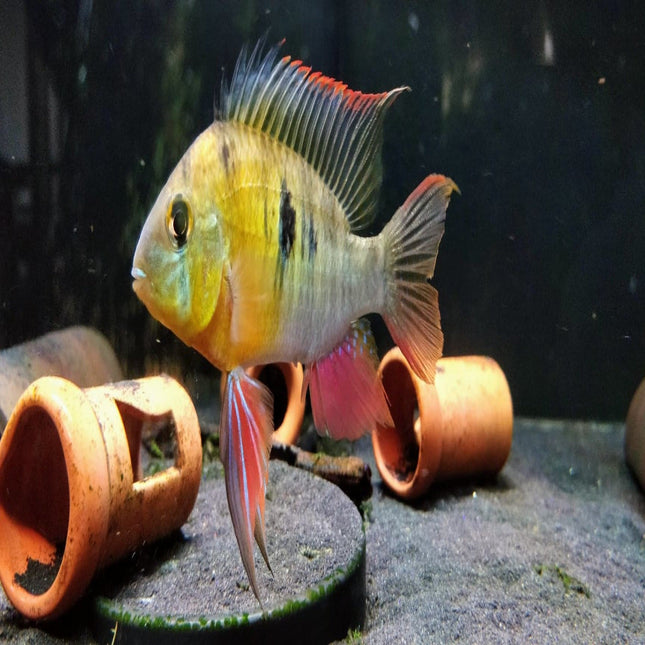
Bolivian Ram: The best Dwarf Cichlid for the Community Aquarium? (Adult Breeder Pictured, only juveniles are for sale) Bolivian Rams (also known as a Bolivian Butterfly), are beautiful freshwater tropical fish that can get along with others without any issues. That is, unless the other critters are a good size smaller, and then they are Bolivian Ram Food. Bolivian Rams (Mikrogeophagus altispinosus) are part of the Dwarf Cichlid family, but they're not as aggressive as other species in this group. This species of fish is endemic to the Amazon River basin in Brazil and Bolivia. The species is similar in profile to the larger Geophagine Cichlids. These guys will make a fantastic addition to your community tank with their striking colours and friendly, gentle dispositions to their tank mates. Life Cycle The average life cycle for a Bolivian Ram is 4 years, but it's not uncommon to see them live much longer. Poor water conditions and lack of food are usually the leading causes for shortened lifespans in this species. Bolivian Ram Appearance Bolivian Rams are quite unlike any other fish. They possess an eye-catching golden brown colour, reddish highlights on the dorsal fin and caudal fins. The Rams shine in the bright light of the fish tank with pearly turquoise-blue highlights on pelvic and anal fins. Finally, they have a black 'spot' located centrally atop its body, with a black line running from top to bottom along eye to head. Bolivian Ram Behaviour The Bolivian Rams have an interesting defence mechanism! They can use their fierce rayed fins as an effective way to defend themselves against predators. The rays help them with impressive agility in the water, and they will spike the mouth of any unfortunate would-be predator. Bolivian Rams have sexual dimorphism, which means they have few physical differences between males and females. However, compared to males, females tend to be smaller overall and display elongated dorsal filaments, which help them attract mates during mating season. Bolivian Ram Size The typical fully grown Bolivian Ram size is around 8 cm in length when fully grown. Males can get slightly more prominent and reach 9cm while females generally stop growing at 7cm. Tank Size Bolivian Ram is a peaceful fish that requires at least 100 litres of space in the tank, alongside dense plant groups and open swimming areas. The best tank for them would be one with plenty of hiding spots as well. Bolivian Ram Care If you want to keep Bolivian Rams, they are relatively easy to care for. But must meet their needs for them to stay healthy. So here is a list of guidelines: Bolivian Ram care starts with the water parameters such as pH and temperature, which should not fluctuate too much, or else this can lead to specific health problems down the line. They prefer soft acidic waters, so don't go overboard on using chemicals like chlorine because these will deteriorate your tank's ecosystem long-term - definitely something no one wants! And make sure there aren't any algae growing either; rinse off rocks twice per week if needed but other than that, follow all directions carefully when adding plants and decorations into your aquarium space. Bolivian Ram Water Parameters The best way to care for a Bolivian Ram is by recreating their natural habitat. It's essential not only in what you have inside your tank but also in the water quality they are subjected to. Ideally, they should be swimming in warm, slightly acidic water with a slow-flowing filter that doesn't overpower them. Water temperature: 26 to 26 degrees Celsius pH levels: 6.0 to 7.5 (ideal is around 6.5) Water hardness: 0 to 10 dKH Diet These omnivorous fish will eat anything you give them. In the wild, they'll sift through rocks for tiny organisms and can also munch on plant material. Bolivian Ram does just fine on dry food. They primarily stay at the bottom and middle of an aquarium, so sinking pellets are what they need to have. To spice up their diet, you can also give them chopped earthworms or brine shrimp once in a while! Bolivian Rams are always hungry, so you should feed them at least twice a day. Tank Mates If you're looking to introduce other fish into your aquarium, the Bolivian Ram is one of the most peaceful and beautiful options. The first thing you need to consider before getting any new species in the tank is size - smaller ones may be seen as food, so try sticking with similarly sized creatures or those that can't fit through a hole large enough for the larger fish's mouth. Bolivian Rams prefer living in groups and love company. They enjoy being with up to 8 fish at a time but do well enough on their own too! Aside from their fellow Bolivian Rams, much other calm-water fish will peacefully coexist in an aquarium without posing much harm. Silver Dollar fish, Emperor Tetras, Rummy Nose Tetras, Kuhli Loaches, Cory Catfish, Dwarf Gourami, Cherry Barbs, Guppies and Platies. Breeding Breeding Bolivian Rams is a relatively easy process and will happen naturally with no special conditions in the tank. But be aware of the varying breeding cycles of the female Rams. Breeders should keep track of how many times each Ram has mated with others; some females will only mate once every few years while others may do it up to three times per year.
$20.00
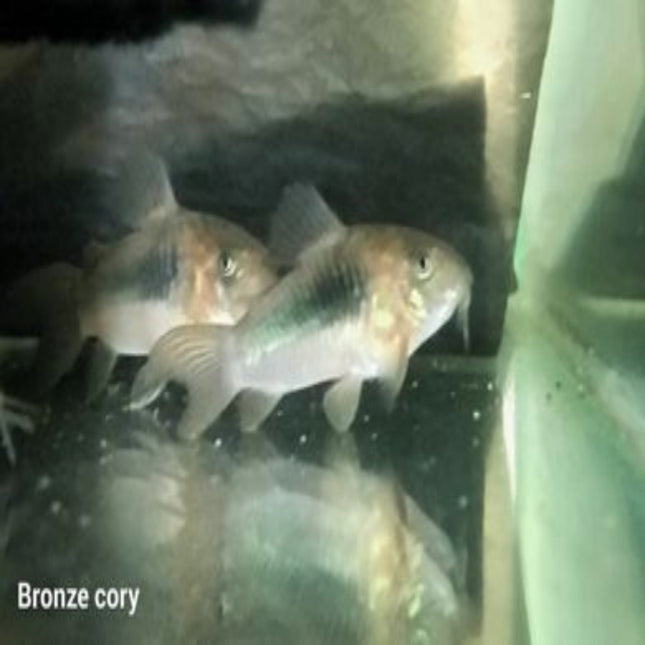
Bronze Corydoras (Corydoras aenus) is a small, peaceful freshwater fish from the family Callichthyidae. It is native to South America, from the Rio Orinoco basin in Venezuela to the Rio Tocantins in Brazil.This fish is a golden bronze color with a black band running along its body, and it has a prominent black stripe on its caudal fin, as well as some black spots on its dorsal fin. They are small in size, reaching up to 3 inches in length, and they have an average lifespan of 5-9 years. They prefer to live in a tank with soft, acidic water, and they should be kept with other fish of similar size and temperament. They are omnivorous, and their diet should include a variety of live and frozen foods. The Bronze Corydoras is an active scavenger and is a great addition to any freshwater community tank.
$10.00

Corydoras Paleatus Albino is a popular freshwater fish that is commonly kept in aquariums. It belongs to the catfish family and is often referred to as the bronze corydoras or the peppered corydoras. This fish is known for its peaceful nature and is a great addition to any community tank. One of the standout features of the Corydoras Paleatus Albino is its unique appearance. It has a bronze-colored body with white stripes running along its sides. The Albino variant of this fish lacks the usual black spots on its body, making it even more eye-catching. It has a streamlined body shape that is designed for fast swimming, making it an active fish that adds a lively energy to any aquarium. The Corydoras Paleatus Albino is a small fish that typically grows up to 2-3 inches in length. They are generally hardy and easy to care for, making them ideal for beginner aquarists. These fish are best kept in groups of at least 6-8 individuals as they are social and thrive in the company of their own kind. They prefer a planted tank with plenty of hiding spots, as well as open swimming areas. In terms of water parameters, the Corydoras Paleatus Albino prefers a pH range of 6.0-8.0, with a temperature range of 72-78°F. They are adaptable to a variety of water conditions, but it is important to maintain stable water parameters to prevent stress and disease. Feeding the Corydoras Paleatus Albino is easy, as they are not picky eaters. They will readily accept a variety of foods, including flake, pellet, and frozen foods. It is important to offer a balanced diet that includes both protein and vegetables to ensure their optimal health. Overall, the Corydoras Paleatus Albino is a great addition to any aquarium. Their unique appearance, peaceful nature, and easy care make them a popular choice among aquarists. At Nano Tanks Australia Aquarium Shop, we take pride in offering high-quality fish that are individually photographed to ensure their premium quality. So why not consider adding the Albino Bronze Corydoras to your tank today?
$9.00
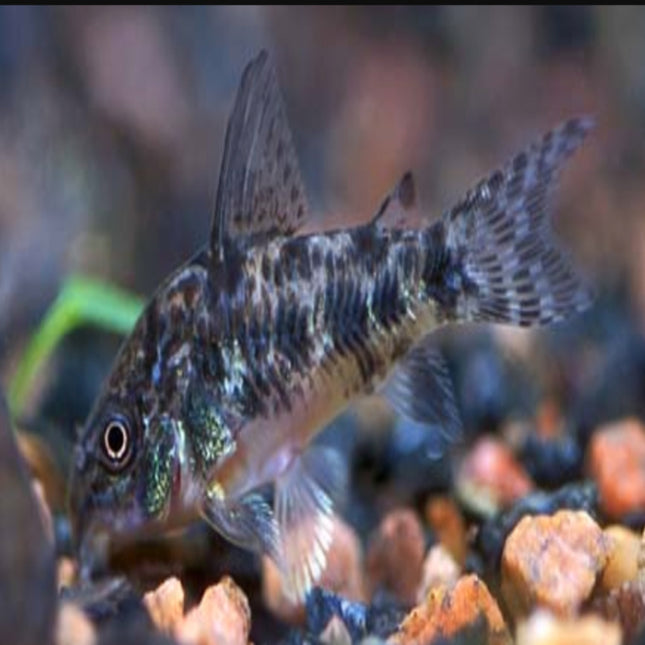
Genus Corydoras Species paleatus Common name Albino Cory Cat Origin South/Central America Tank Size min. 60 – 100 cm Temperature 22 – 25 °C pH Value 5.0 – 6.0 Fish Size 6-7 cm Food Omnivore Care Sociable, Group, Diurnal
$15.00
![[ARRIVED 21 - AUG - 2025] Nisso B - 1 Battery Operated Air Pump - Nano Tanks Australia](http://nanotanksaustralia.com.au/cdn/shop/files/arrived-21-aug-2025-nisso-b-1-battery-operated-air-pump-4088375.jpg?v=1755782725&width=645)
The Nisso B-1 Battery-Operated Air Pump is a portable device designed to provide aeration in situations such as water changes, fish transportation, or power outages. Its battery-operated functionality ensures continuous operation without the need for a direct power source. Key Features: Portability: Compact and lightweight, making it convenient for use during fish transport or emergencies. Battery Operation: Operates on batteries, eliminating the need for charging and ensuring functionality during power outages. Included Accessories: Comes with an air stone and tubing for immediate use. Specifications: Dimensions: Approximately 9 cm (W) x 18 cm (D) x 5 cm (H) Weight: Approximately 187 grams Battery Type: Requires two D-cell batteries (not included) This air pump is suitable for aquarium enthusiasts and anglers needing a reliable aeration solution in various scenarios. Its ease of use and portability make it a practical choice for maintaining adequate oxygen levels for aquatic life.
$49.00
![[ARRIVED 21 - AUG - 2025] Nisso B - 5 Battery Operated Air Pump - Nano Tanks Australia](http://nanotanksaustralia.com.au/cdn/shop/files/arrived-21-aug-2025-nisso-b-5-battery-operated-air-pump-3187464.jpg?v=1755869448&width=645)
The Nisso B-5 Battery-Operated Air Pump is a compact and portable device designed to provide reliable aeration during activities such as water changes, fish transportation, or power outages. Its battery-operated functionality ensures continuous operation without the need for a direct power source, making it an essential tool for aquarium enthusiasts and anglers. Key Features: Portability: Compact and lightweight design allows for easy transport and use in various situations. Battery Operation: Operates on two AA batteries (not included), eliminating the need for charging and ensuring functionality during power outages. Included Accessories: Comes with an air stone and tubing for immediate setup and use. Continuous Operation: Capable of running continuously for approximately 20 hours on fresh batteries. Specifications: Dimensions: Approximately 6.5 cm (W) x 3.4 cm (D) x 7.3 cm (H) Weight: Approximately 107 grams Battery Type: Requires two AA batteries (not included) Air Output: Approximately 0.5 liters per minute (may vary depending on battery condition) The Nisso B-5 is suitable for both freshwater and seawater applications, making it versatile for various aquatic environments. Its ease of use and portability make it a practical choice for maintaining adequate oxygen levels for aquatic life in diverse scenarios.
$33.00
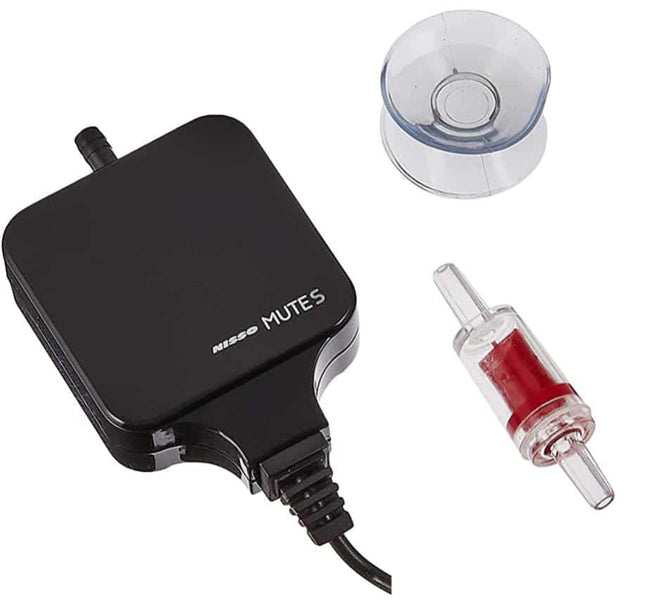
The Nisso Mute Air Pump Black is a quiet and efficient air pump perfect for small to medium-sized aquariums. It delivers reliable aeration at 280ml/minute while operating at a whisper-quiet ≤30dB, ensuring a peaceful environment for both you and your aquatic life. Its compact and sleek design, along with included accessories, makes it easy to install and maintain in any aquarium setup.
$27.95
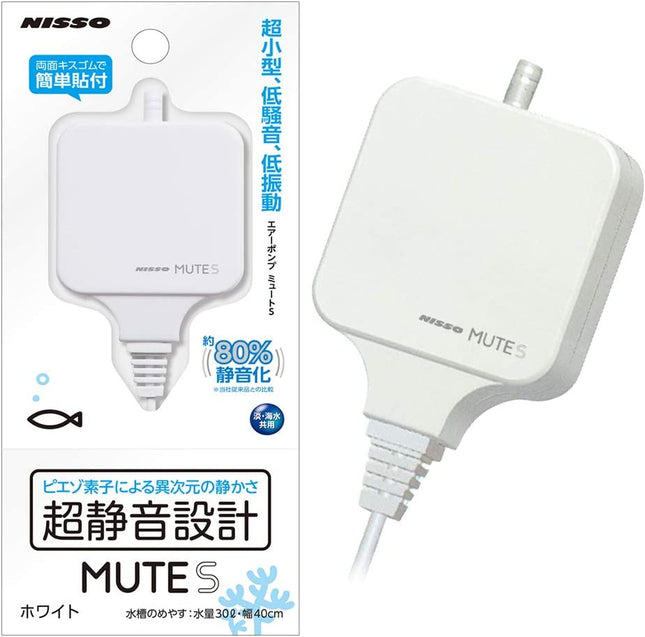
The Nisso Mute Air Pump White is a quiet and efficient air pump perfect for small to medium-sized aquariums. It delivers reliable aeration at 280ml/minute while operating at a whisper-quiet ≤30dB, ensuring a peaceful environment for both you and your aquatic life. Its compact and sleek design, along with included accessories, makes it easy to install and maintain in any aquarium setup
$27.95
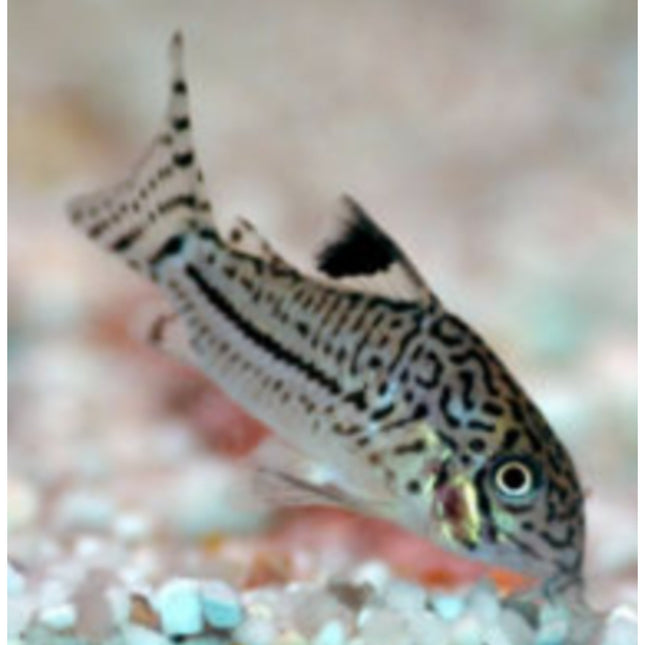
Three stripe - Juli's Cory Catfish (Corydoras trilineatus) OVERVIEW: Scientific Name Corydoras julii Family Callichthyidae Common Names Julii cory, julii cory fish, julii catfish Ease of keeping Easy Lifespan 7 years and more Tank size 30 gallons and more Temperament Peaceful Tank type Community of fishes Diet Omnivorous bottom feeder Temperature 72-78 °F (22-26 °C) pH 6.0-8.0 Water hardness 2–20 dGH Size up to 3 in (7.5 cm) The three-stripe corydoras is a freshwater fish that lives in the Amazon River basin and coastal rivers of South America. They are not aggressive fish, but they will defend their territory by chasing away other fishes with an impressive display of fins waving back and forth. When you are looking for a fish to keep in your aquarium, consider the three stripe corydoras. It is an interesting and peaceful species that can grow up to 2.5 inches (6.1 centimeters) long! The three-stripe corydoras live in water with pH levels between 6-8 as well as temperatures ranging from 72-79 degrees Fahrenheit, which makes it suitable for most homes' environments without needing specific care requirements or changes of temperature over time like some other animals might need. This type of animal feeds on worms, benthic crustaceans, insects, and plant matter among others so there will never be any food shortages when keeping one indoors either - perfect if you're trying not just to want something nice but also easy. COLOR: The colour of this fish is not what it seems. The underside is pale white, while the top side has a greenish tint to its skin that sparkles in the water. Three long stripes run along their sides and five vertical striped lines extend from head to tail on both fins for an amazing effect when swimming in open waters! BEHAVIOR: This shy fish is an interesting creature to observe, and planning a large group of three-band Corydoras will help them become more confident. They are said to be quite fearful because they find comfort in the presence of their fellow tankmates as well! COHABITATION: Corydoras trilineatus is a three-lined Corydoras species that has until recently been underappreciated in the aquarium world. They are very peaceful and never disturb other inhabitants, making them an ideal fish for anyone who wants to keep more than one type of animal together without any fighting or risk to their personal safety. BREEDING: When you want to breed your corydoras, make sure they are at a stage where their eggs have the best chance of hatching. Cory catfish can get pregnant any time between 3-8 years old but it's typically after age 5 when females produce bigger and better quality fry! Before this point in life, young female fish will still be able to give birth on occasion with some success or may lay infertile eggs which are more likely than fertile ones to become infected by a fungus that turns them into jellyfish looking deflated blobs. AQUARIUM: Corydoras prefer to inhabit tanks with rough surfaces and strong water currents for feeding. They can often be found near the bottom of a tank grazing on algae, detritus, or other filter-feeding organisms like shrimp. With small mouths but voracious appetites, these little fish are perfect for eating whatever gets stuck in your aquarium filters! FEEDING: Corydoras trilineatus is not difficult to feed, but it's always important to consider its preferred food. For perfect health, vary this basic diet with contributions in plants and invertebrates like tubifex or daphnia. And for the ultimate treat? Give them vase worms! If your Corydoras are struggling because other fish eat their meal faster than they can get at it during the day when lights are on- make sure you distribute meals only after dark so that all of your aquarium occupants have an equal chance of eating well without feeling threatened by one another.
$25.00 $14.00
![[ARRIVED 21 - JUN - 2025] Aquael Turbo Filter 1000 - Nano Tanks Australia](http://nanotanksaustralia.com.au/cdn/shop/files/arrived-21-jun-2025-aquael-turbo-filter-1000-723865.jpg?v=1750475599&width=645)
The Aquael Turbo Filter range is a series of high-performance internal filters designed for use in aquariums, offering efficient water filtration and aeration. These filters are popular among aquarists for their versatility, reliability, and quiet operation. The Turbo Filter range caters to tanks of various sizes, from small to large aquariums, making them suitable for both beginners and experienced aquarium hobbyists. Key Features of the Aquael Turbo Filter Range: Multi-Stage Filtration: Mechanical Filtration: Each filter comes with a sponge that captures debris and particulate matter, ensuring clean and clear water. Biological Filtration: The filters provide space for bio media such as BioCeraMAX or other biological media, promoting the growth of beneficial bacteria that break down harmful substances like ammonia and nitrites. Chemical Filtration (Optional): The modular design allows the addition of chemical filtration media, such as activated carbon, to remove dissolved impurities, odors, and discolorations. Modular and Customizable Design: The Aquael Turbo Filters are designed to be flexible. The user can modify and expand the filter media by adding or replacing various types of media (sponges, bio media, carbon, etc.), making the filter suitable for different tank environments (freshwater or marine). The modular design makes maintenance easy, allowing for quick disassembly and cleaning. Adjustable Flow Rate: Each filter in the range comes with an adjustable flow rate, allowing the user to control the water circulation based on the needs of the tank’s inhabitants. This is particularly useful for sensitive species that require less water movement or for high-flow environments. Efficient Aeration: The filter also serves as a powerful aerator, ensuring that the water is well oxygenated. This is important for maintaining high oxygen levels in the water, which benefits both fish and beneficial bacteria in the tank. Quiet and Energy-Efficient: The filters are designed to operate quietly, thanks to suction cups with rubber elements that reduce noise and vibration. Despite their powerful filtration capabilities, the Turbo Filters are energy-efficient, consuming minimal electricity during continuous operation. Durability and Long-Lasting: The Aquael Turbo Filters are built to last, using high-quality materials and a reliable motor. They are ideal for long-term use in a wide range of aquariums. Available Models: The Aquael Turbo Filter range offers different models to accommodate various tank sizes: Turbo 500: Suitable for tanks up to 150 liters. Turbo 1000: Suitable for tanks up to 250 liters. Turbo 1500: Suitable for tanks up to 350 liters. Turbo 2000: Suitable for tanks up to 500 liters. Each model has an increasing filtration capacity, power, and flow rate, making them ideal for different aquarium setups, from small freshwater aquariums to large marine environments. Ideal For: Freshwater and Marine Tanks: These filters are versatile enough for both freshwater and saltwater environments. Planted Aquariums: With the adjustable flow rate, they are suitable for planted tanks where too much water movement can disturb plants. Aquariums with Sensitive Species: The ability to control water flow and oxygenation makes them suitable for aquariums housing delicate or slow-moving species. Conclusion: The Aquael Turbo Filter range offers an effective and flexible solution for aquarium filtration needs. With its combination of mechanical, biological, and optional chemical filtration, along with customizable features, the range is suitable for a wide variety of tank setups. The durability, quiet operation, and ease of maintenance make these filters a top choice for aquarium enthusiasts looking for reliable, long-lasting filtration systems.
$126.00
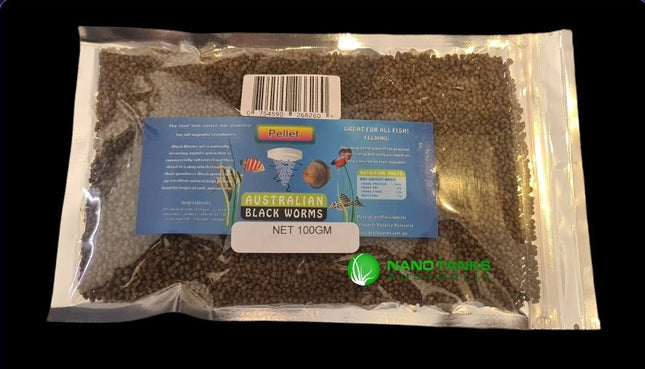
Unleash the Predatory Instinct. The Power of Live Blackworms, in a Pellet. Give your fish the taste they crave without the hassle! Our Blackworms Pellets are a revolutionary, convenient formula that captures the nutritional power and irresistible flavour of live blackworms. These slow-sinking pellets are packed with protein to fuel growth, enhance vibrant colours, and stimulate feeding response in even the most finicky eaters. It's the ultimate high-reward food for discerning fish. Key Features & Benefits: Irresistible Flavour Profile: Formulated with real blackworm meal as a primary ingredient, this pellet triggers a powerful feeding instinct in carnivorous and omnivorous fish. Promotes Growth & Colour: Exceptionally high protein content supports muscle development, energy, and brings out the most vibrant reds, oranges, and natural colours in your fish. Ideal for Picky Eaters: The scent and taste are known to entice difficult-to-feed species like wild-caught fish, discus, bettas, and bottom dwellers onto a prepared diet. Sinking Formulation: The dense pellet sinks quickly, making it perfect for mid-water and bottom-feeding fish like loaches, catfish, cichlids, and goldfish. Clean & Safe: A safe, nutrient-dense alternative to live blackworms, free from parasites and contaminants. It also produces less waste than live foods, supporting cleaner water. Product Details: Product Name: Blackworms Pellets Size: 100 Gram Bag Pellet Type: Sinking Key Ingredient: Blackworm Meal Protein Content: High (e.g., >45%) Life Stage: Suitable for juveniles and adult fish. How To Use: Feeding Guide: Feed 2-3 times daily. Offer only what your fish can consume within 1-2 minutes. Pro Tip: For surface feeders like bettas or gouramis, you can pre-soak a pellet for 30 seconds until it softens and then feed. For Best Results: Use as part of a varied diet alongside other high-quality foods like flakes, frozen, and live treats. Who is this food for? Blackworms Pellets are the ideal choice for: Owners of discus, bettas, angelfish, and dwarf cichlids. Keepers of bottom feeders like loaches, Corydoras, and catfish. Hobbyists with picky or newly acquired fish that need encouragement to eat. Anyone wanting to boost protein intake for growth and colour enhancement. Order with Confidence: This 100g bag offers excellent value and is perfect for trying this premium food or for feeding a single aquarium. For multiple tanks or larger fish, see our larger size options. FAQ Section (Suggested for the product page): Q: My fish are picky and only eat live food. Will they eat this?A: Yes! This is one of the best foods for weaning fish off live diets. The strong scent and flavour of blackworms are highly appealing. Try soaking the pellet in a bit of tank water to release more scent initially. Q: Are these pellets good for fish that need a high-protein diet?A: Absolutely. With blackworm meal as a leading ingredient, these pellets are formulated to be protein-rich, making them an excellent staple for carnivorous and omnivorous species. Q: Can I feed this to my community tank?A: Yes, it is an excellent food for a mixed community. The sinking nature ensures all levels of the tank get fed, from top-dwelling fish that will snatch it as it sinks to the bottom-feeders who will clean up the rest. Q: How does this compare to frozen blackworms?A: These pellets offer similar nutritional and flavour benefits but with much greater convenience, a longer shelf life, and without the risk of introducing parasites or pollutants that can sometimes come with live/frozen foods.
$26.00
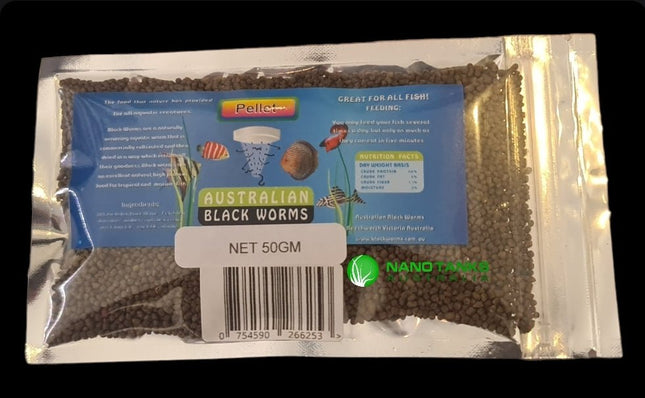
Black Worm Pellets are a type of fish food that are commonly used to feed aquarium fish. They are made from dried, compressed blackworms, which are a type of freshwater worm that is commonly used as a food source for aquarium fish. The pellets are usually small, dark in colour, and have a soft, moist texture. They are often used as a supplement to other types of fish food, as they are a high-protein and nutritious food source that can help to promote healthy growth and vibrant colours in fish. Black worm pellets are also a popular food source for bottom-dwelling fish, as they sink to the bottom of the aquarium where these fish can feed on them. Nutritional Facts Crude Protein 40% Crude Fat 5% Crude Fibre 1.1% Moisture 3%
$15.00
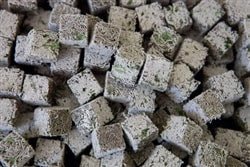
Australian Black Worms (aka Tubifex worms) are a natural food that nature provides and are readily taken by aquatic creatures. They make a great high-protein treat for fish, especially fish looking for food with a lot of protein. Our worms are sold in both loose form and in cubes. Clean Food Because the worms are killed and boiled before they are cleaned, they go though the same cleaning and purging process as if they were going to be fed live. They are then frozen in 2.5 kg blocks and loaded into the Cuddens freeze drier. A vacuum pump creates an airless environment by removing all the air from a chamber, then heats it from minus 20C to 50c. Water boiled at 0 degrees Celsius in a vacuum. As frozen worms started to thaw, all moisture turned into vapour that was then refrozen on coils inside the chamber. The process of freeze drying is a little more complicated then that, but the basis for how it works is this. The important thing about the freeze-drying process is that it removes all moisture from worms without altering their nutritional facts. The whole process from growing, cleaning and processing to produce your final product begins at a facility in order to ensure you get top quality food grade products each time! Disease-free Australia has very few if any diseases that are transmitted from water to fish, and the area where these black worms live is away from farming and industrial areas. The worm's water used to come straight out of the same supply we drink our drinking water out of up until recently. Difference between live worms and freeze-dried worms The only difference between the two is that live worms contain water. Different ways to feed cubes. To get fish to show interest in your freeze-dried worms, put one cube inside the tank halfway down. The fish will then be more inclined to eat it. When they do, try placing another closer to the surface so your pet can grab them easier! Australian Freeze Dried Black Worms are one of the most nutritious foods for Discus, Corydoras and other fish types as well. This has bio pigment laced through it that is designed for bringing out the red and yellow of the fish. This is a natural colour enhancer made primarily from Carrots. They consist of 45% crude protein and is 8x more condensed then Live Black Worms
$89.00

Add a Splash of Australian Brilliance with Pacific Blue Eyes! Short Description:Light up your aquarium with the shimmering Pacific Blue Eye!Known for their stunning blue iris and peaceful nature, these hardy Australian native fish are perfect for community tanks, planted aquariums, and even outdoor ponds. Watch their active schooling behavior and enjoy their mosquito-larvae hunting skills. --- Key Features & Highlights · 👁️ STUNNING BLUE EYES: The defining feature is their brilliant, luminescent blue eyes that stand out in any aquatic setting.· ☮️ PEACEFUL COMMUNITY FISH: Ideal inhabitants for community tanks with other small, non-aggressive fish like small rainbowfish, tetras, or guppies.· 🌿 HARDY & ADAPTABLE: Tolerate a wide range of water conditions, including temperature fluctuations from 18°C to 28°C (64°F - 82°F), and can live in freshwater to slightly brackish water.· 🐟 ACTIVE SCHOOLING BEHAVIOR: Best kept in groups of 6-10+, they display fascinating natural shoaling behavior, especially when males showcase their colors and extended fins to court females.· 🦟 NATURAL PEST CONTROL: Excellent for garden ponds and aquariums, as they actively feed on mosquito larvae without harming tadpoles or frog eggs. --- Detailed Description Bring a piece of Australian ecosystems to your home with the captivating Pacific Blue Eye. These slender, silvery fish are not just beautiful; they are dynamic and hardy additions that bring life and movement to the middle and top levels of your aquarium. Males are particularly striking, developing longer finnage and often exhibiting orange tones on their fins during courtship displays. They thrive in a well-planted tank with some open swimming space, and their adaptability makes them an excellent choice for both beginner and experienced aquarists. Ideal For: · Planted community aquariums· Nature-style aquascapes· Outdoor garden ponds· Beginner-friendly setups· Species-specific display tanks --- Specifications & Care Guide Parameter RequirementScientific Name Pseudomugil signiferTank Size 60+ litres (approx. 15+ gallons)Temperature 18°C - 28°C (64°F - 82°F)pH Range 6.5 - 8.0Water Hardness Soft to hard (adaptable)Adult Size 3 - 7.5 cm (1.2 - 3 inches)Diet Omnivore (Flakes, micro-pellets, brine shrimp, daphnia)Temperament PeacefulLifespan 2-4 years in captivity --- Important Care Notes · SCHOOLING NATURE: For their well-being and to see their most natural behavior, keep them in a group of at least six, but preferably ten or more.· TANKMATES: Choose peaceful companions. Avoid long-finned, slow-moving fish (like some gouramis) that might be targets for fin-nipping.· SENSITIVE TO CHANGE: While hardy once established, they can be sensitive to rapid changes in water chemistry during acclimation. Drip acclimation is recommended.· BREEDING: They breed readily in captivity, scattering eggs over fine-leaved plants or spawning mops. --- Live Arrival Guarantee Our Pacific Blue Eyes are carefully acclimated and packed with the utmost care for their journey. We offer a live arrival guarantee to ensure your fish arrive healthy and ready for their new home. Add a school of these brilliant blue-eyed beauties to your aquatic community today!
$12.00
![[ARRIVED 21 - SEP - 2025] Medaka Breeding Spawning Mop - Premium Egg Collection System - Nano Tanks Australia](http://nanotanksaustralia.com.au/cdn/shop/files/arrived-21-sep-2025-medaka-breeding-spawning-mop-premium-egg-collection-system-9409924.jpg?v=1758460018&width=645)
Boost Your Medaka Breeding Success! Short Description: Maximize your Medaka ricefish breeding results with our specialized Spawning Mop!This premium egg collection system provides the perfect spawning site for your fish while making egg harvesting incredibly easy. Designed specifically for Medaka breeding behaviors, this mop helps protect eggs and increase hatch rates. --- Key Features & Highlights · 🎣 OPTIMAL SPAWNING SURFACE: Perfect fiber density and length that mimics natural spawning vegetation, encouraging Medaka to deposit eggs consistently · 🔍 EASY EGG HARVESTING: Simply remove the mop and gently roll eggs off into your incubation container - no more searching for scattered eggs! · 🛡️ EGG PROTECTION SYSTEM: Keeps eggs safe from adult fish predation, significantly increasing hatch rates and fry survival · 🌿 AQUARIUM-SAFE MATERIALS: Made from 100% non-toxic, fish-safe synthetic fibers that won't affect water quality · ⚡ QUICK SETUP: Ready to use immediately - just rinse and place in your breeding tank --- Detailed Description Transform your Medaka breeding experience with our professionally designed Spawning Mop! Created specifically for the unique spawning behaviors of Japanese Ricefish, this mop provides the ideal egg-deposition surface that Medaka naturally seek out. The carefully selected fiber type and length perfectly mimic their preferred natural spawning substrates, encouraging regular egg laying and making collection effortless. Unlike trying to find tiny eggs scattered throughout your tank or plants, our spawning mop concentrates egg deposition in one easy-to-access location. This means less stress for your fish during breeding and dramatically simpler egg harvesting for you. The dense fibers protect eggs from being eaten by adults while allowing optimal water flow for healthy development. Perfect for both beginner breeders and professional operations, this mop simplifies the entire spawning process while increasing your overall yield. Watch your Medaka readily adopt the mop as their preferred spawning site within days! Ideal For: · Medaka (Japanese Ricefish) breeding · Other small egg-scattering fish · Beginner and expert breeders alike · Home hobbyists and commercial operations · Schools and educational programs --- Specifications & Usage Guide Parameter Details Material 100% fish-safe synthetic yarn Length 6-8 inches hanging length Color Options Green, Tan, White Package Includes 2 spawning mops with suction cups Tank Size Suitable for 5+ gallon tanks Compatibility Perfect for Medaka, also works for other small egg-scatterers --- How To Use: 1. Rinse gently before first use 2. Attach suction cup to tank glass 3. Position mop in breeding tank 4. Wait for Medaka to spawn (usually within 1-3 days) 5. Remove mop and gently roll eggs off into incubation container 6. Return mop to tank for continued spawning --- Maintenance Tips · Cleaning: Gently rinse in tank water during water changes · Replacement: Recommended every 3-4 months for optimal performance · Storage: Keep dry when not in use · Multiple Mops: Use 2-3 mops in rotation for continuous spawning --- Important Notes · ⚠️ MATURE FISH REQUIRED: Ensure your Medaka are breeding-conditioned · 🚫 AVOID CHEMICALS: Never clean with soaps or detergents · 🔍 REGULAR CHECKING: Check for eggs daily during breeding season · 🌡️ OPTIMAL CONDITIONS: Maintain proper Medaka breeding parameters (72-78°F, pH 7.0-8.0) · 🐟 HEALTHY STOCK: Start with well-conditioned, healthy breeding fish --- Breeding Success Guarantee Our spawning mops are proven effective by professional Medaka breeders. While individual results depend on your fish and setup, this mop provides the optimal tool for successful egg collection and protection. Ready to revolutionize your Medaka breeding? Add our Spawning Mop to your setup today!
$10.00

IMPORTANT FOR SHRIMP AND AQUATIC LIFE HEALTH WHILE DE-IONIZING WATER AND CONTRIBUTING TO AQUARIUM AND PLANT MINERAL ENRICHMENT Tourmaline Mineral Spheres made of tourmaline stone are a must have for freshwater shrimp, crayfish, snails, bettas and goldfish. Each ball measures approximately 25mm in size. They slowly and safely release minerals and elements. Lasting for 1–2 years these balls slowly break down releasing elements such as: aluminum, iron, magnesium, sodium, lithium, potassium and many other essential minerals. Benefits to aquatic life Improved shrimp and crustacean molting, enhanced colours, higher breeding & survival rates as well as overall improvement to growth and health. Benefits to aquarium water Purification by de-ionization and stability of pH. GH can be raised if used at a high dosage. Benefits to soil and plants Plant absorption of elements when the balls are pushed into the soil around the plants. In addition, they also provide a large surface area for beneficial bacteria to grow on. If placed on the surface of the substrate the spheres provide an excellent surface area for algae to grow which shrimp and other aquatic life can graze on. DIRECTIONS 1 ball per 8 litres of water.
$1.00
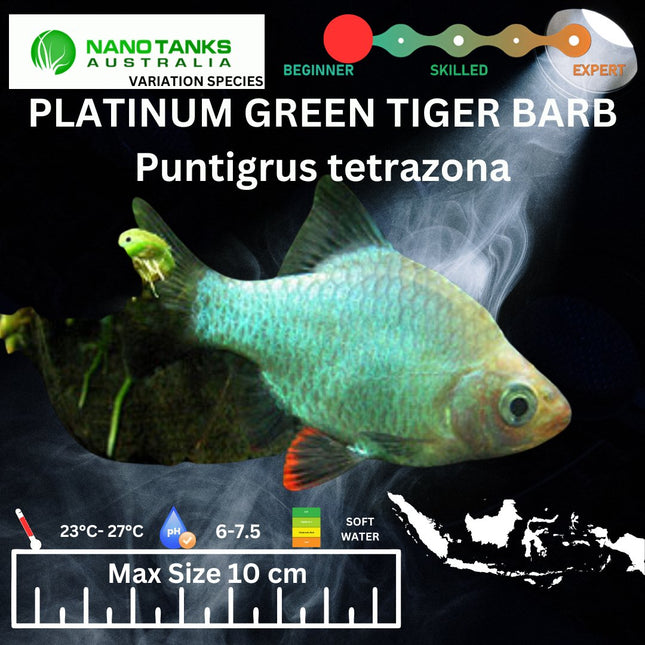
Appearance Tiger Barbs have an iconic look that even novice fish-keepers will instantly recognize. The body of the fish is quite wide. It’s tallest at the middle point and tapers down to a triangular-shaped snout. These fish are also quite colorful and have a very distinct pattern. The base color of Tiger Barbs is usually golden yellow. Some also have subtle rose gold tint. On top of that base color are several stripes. Care Tiger Barb care isn’t too difficult and can be handled by aquarists without much experience (assuming you stick to the recommendations in this guide). Otherwise, they wouldn’t be as widespread as they are! In general, these fish are relatively hardy and can adapt to simple setups as long as you cover the basics. That said, there are some aspects of their care that’ll require a bit of special attention. Despite their small size and beautiful looks, their strong personalities can be a handful! Here are the main care recommendations you need to know. Tank Size The minimum tank size for a small group of Tiger Barbs should be at least 20 gallons. However, we recommend going with a 30-gallon tank if you can. As we mentioned earlier, these fish are avid swimmers. The more room they have, the better. Plus, ample room to swim may help stave off aggressive behavior. Water Parameters In the wild, you can find Tiger Barbs inhabiting lakes, streams, and swamps that are lined with trees. Thanks to the decaying plant matter in the water, conditions tend to be more acidic. For the best results, you need to mimic their natural environment as closely as possible. That includes getting the water conditions just right. Luckily, the Tiger Barb can tolerate a generous range of conditions. As long as you stick within the following ranges, your fish should have no problem staying healthy. Water temperature: 68°F to 82°F degrees (aim for around 74°F if possible) pH levels: 6.0 to 8.0 (a slightly acidic 6.5 is best) Water hardness: 4 to 10 dKH To ensure that the aquarium has the proper water parameters you should invest in a reliable and accurate test kit. This will help you have confidence in the readings you’re getting, allowing you to make the right adjustments when necessary.
$9.00
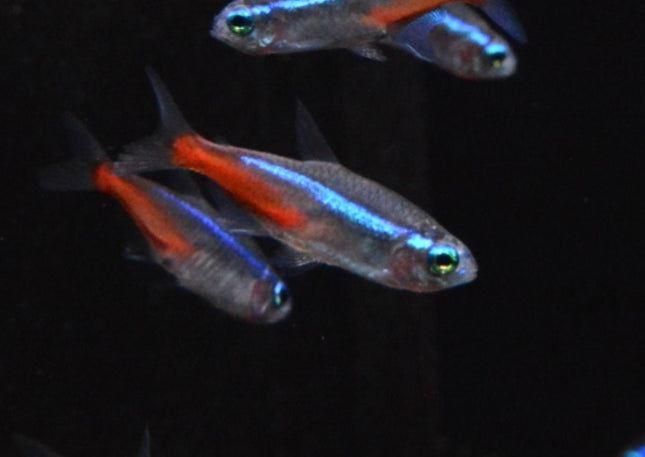
Characteristics Family Characidae Origin Southeastern Colombia, eastern Peru, western Brazil Social Peaceful Tank Level Mid-dweller Minimum Tank Size 10 gallon Diet Omnivore Breeding Egg scatterer Care Intermediate pH 7 Hardness Up to 10 dGH Temperature 68 to 79 F (20 to 26 C) Origin and Distribution Neon tetras originated from the clear water and blackwater streams and tributaries in the Orinoco and Amazon river basins in Brazil, Columbia, and Peru. These are regions of blackwaters beneath dense forest canopies that allow very little light to get through. Neon tetras live in shoals mainly in the middle water layers and feed on insects, worms and small crustaceans. Neon tetras are generally all captive-bred, with most coming from fish farms in the Far East and Eastern Europe. Several varieties of captive-bred specimens are now available. These include the long-finned neon tetra, though they are rather rare, as well as a golden strain that is basically a semi-albino variety, and a diamond neon tetra that appears sprinkled with metallic scales along the top portion of the body. One variety has the blue stripe but not the red coloration. Colors and Markings The neon tetra has a slender torpedo-shaped body that reaches no more than an inch and a half in length. What this fish lacks in size, they make up for in color. From the tip of the nose to the adipose fin, the neon tetra has a bright neon blue stripe. It is believed this bright stripe makes them more readily visible to each other in blackwater conditions. Below the blue stripe, the neon tetra sports a white-silver belly. Past the belly, a bright red stripe extends all the way to the tail. The striking red, white, and blue combination make the neon tetra one of the most popular of all aquarium fish. The fish is rivaled only by the cardinal tetra, for which they are often mistaken. The key difference between the two fish is the red stripe. In the neon tetra, it only extends from the middle of the body to the tail. In the cardinal tetra, the red stripe runs the entire length of the fish, from snout to tail. Like other colorful fish, the bright colors of the neon tetra will fade at night when they are resting, when they become alarmed or when they are ill. At the pet store, choose specimens that are actively swimming and robustly colored, as faded colors can be an indication of poor health. Tankmates Neon tetras are peaceful fish that get along well with most community fish. Always keep neon tetras in schools of a half dozen or more as they are a shoaling species that requires the presence of others of their kind. Neon tetras do well in a community tank as long as the other species are not large or aggressive. Small peaceful fish such as rasboras, small tetras, dwarf gouramis, corys, and other small catfish are good choices as companions. Avoid larger tetras, as they will eat neon tetras at the first opportunity. The rule of thumb is, if the mouth of the fish opens large enough to swallow the neon, they will do it sooner or later.
$4.00
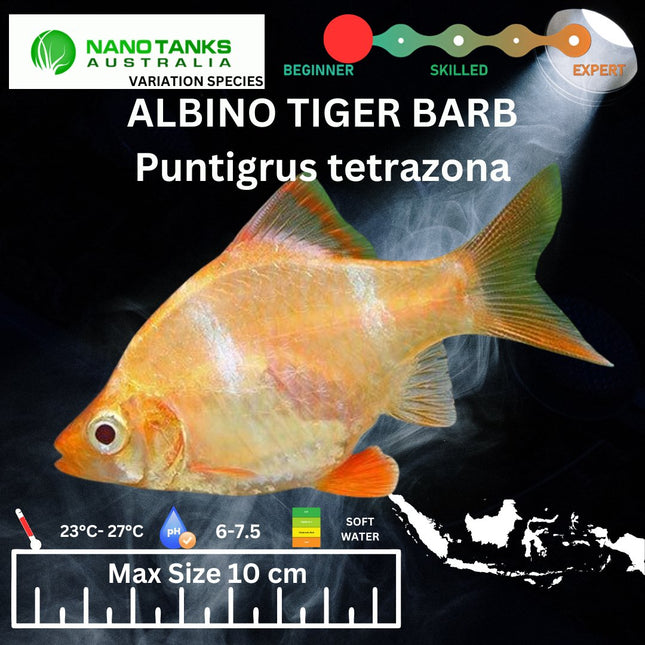
Appearance Tiger Barbs have an iconic look that even novice fish-keepers will instantly recognize. The body of the fish is quite wide. It’s tallest at the middle point and tapers down to a triangular-shaped snout. These fish are also quite colorful and have a very distinct pattern. The base color of Tiger Barbs is usually golden yellow. Some also have subtle rose gold tint. On top of that base color are several stripes. Care Tiger Barb care isn’t too difficult and can be handled by aquarists without much experience (assuming you stick to the recommendations in this guide). Otherwise, they wouldn’t be as widespread as they are! In general, these fish are relatively hardy and can adapt to simple setups as long as you cover the basics. That said, there are some aspects of their care that’ll require a bit of special attention. Despite their small size and beautiful looks, their strong personalities can be a handful! Here are the main care recommendations you need to know. Tank Size The minimum tank size for a small group of Tiger Barbs should be at least 20 gallons. However, we recommend going with a 30-gallon tank if you can. As we mentioned earlier, these fish are avid swimmers. The more room they have, the better. Plus, ample room to swim may help stave off aggressive behavior. Water Parameters In the wild, you can find Tiger Barbs inhabiting lakes, streams, and swamps that are lined with trees. Thanks to the decaying plant matter in the water, conditions tend to be more acidic. For the best results, you need to mimic their natural environment as closely as possible. That includes getting the water conditions just right. Luckily, the Tiger Barb can tolerate a generous range of conditions. As long as you stick within the following ranges, your fish should have no problem staying healthy. Water temperature: 68°F to 82°F degrees (aim for around 74°F if possible) pH levels: 6.0 to 8.0 (a slightly acidic 6.5 is best) Water hardness: 4 to 10 dKH To ensure that the aquarium has the proper water parameters you should invest in a reliable and accurate test kit. This will help you have confidence in the readings you’re getting, allowing you to make the right adjustments when necessary.
$7.00
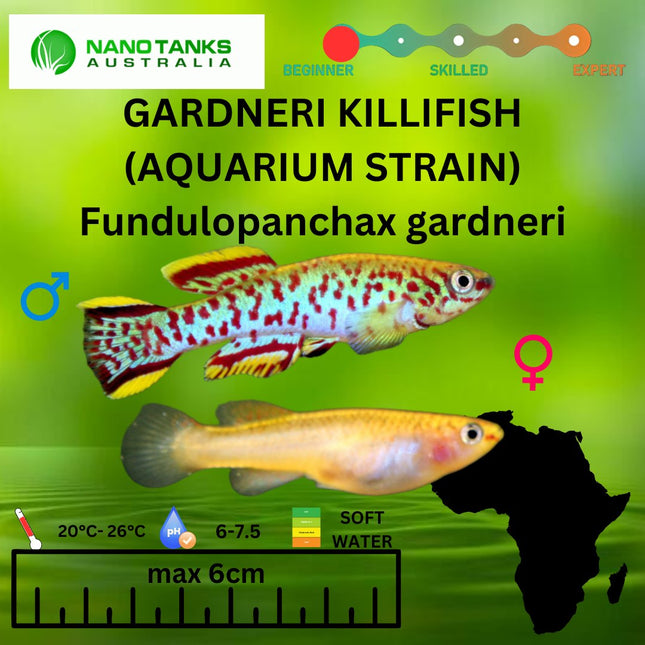
Described By: (Boulenger), 1911 😊 Description Temperament Peaceful Predator Colour Form Varied Bright Colours. Males - Coloured Bodies and Tails ♂️ Females - Brownish in colour ♀️ Lifespan Roughly 5 years Diet 🥩 Carnivores - feeds on pellets, live foods and frozen foods. Minimum Tank Size 20 Litres Tank Setup Plants - Such as Duckweed, Anubias or Java Fern with many rocks and woods. Such as Dragon Stone, Dragon Wood, Quan Woods. Compatibility Peaceful - However due to the size please be aware that it can be eaten by bigger fish. ⚠️ This is an aquarium strain - this means that the strain of fish has been farm raised by many generations. The location for which this Killifish is caught has been lost. The Fundulopanchax gardneri Killifish is native to the Cross River system in southeastern Nigeria and western Cameroon plus the Benue River drainage in central Nigeria. The Gardneri Killifish, also known as Aphyosemion gardneri is an attractive fish that adds vibrancy to the community aquarium. This species of killy lives in Africa and was named after a Dutch word for channel or ditch because its native habitat is small of water. Fundulopanchax gardneri Killifish adds vibrant colour to the community tanks with their bright blue/green bodies spotted with red spots. The male lyretail anthias are a vivid blue/green with many red spots over their body. The tips of the dorsal, anal and caudal fin have golden fringes that run along with them. Meanwhile, females are less intensely coloured with small brown spots covering their bodies instead of complex patterns like males do. This species is known for having short extensions on its tail fins which result in an effect called "lyretails." There's such variety between color varieties it can be hard to keep track! 😊 Tank Requirements Gardneri Killifish are not picky and can adapt to a variety of water conditions. These fish prefer heavily planted tanks with softer, acidic water. To start with the setup you can cover the aquarium with plants and mops. Filtering that uses air is recommended since it won’t harm eggs or fry while they grow in size. Lighting isn't necessary but if used shouldn't be harmful to the growth of filamentous algae either. 😊 Reproduction The Gardneri Killifish is not an annual species. Their eggs do not need to be removed from the water after spawning - they can simply lay their eggs within a spawning mop or java moss, which are common types of vegetation in fish tanks. The parents don't even have to eat during this time period! It's very easy for their breed and once hatched, place the fry into a small tank with a newly hatched brine shrimp as a food source. Be sure that you cover your holding tank because these babies will jump out if given half the chance! 😊 Similar Species of Killifish: Many species of Fundulopanchax gardneri and other members in the genus are found throughout Africa - amieti, arnolde, fallace, filamentosum mireabileis puerzli robertsoni rubrolabbiales sjoedstedti walkeri 😊 Are Gardneri killifish aggressive? While the Killifish is a rather peaceful fish they can become aggressive to other female Killifish as well as other fish when breeding. If you want an all-male community tank, however, keep them with unassuming and colourless fishes like plecos or loaches.
$15.00
![[PREORDER] Aqua - Pics Clear Water Block 20g - Nano Tanks Australia](http://nanotanksaustralia.com.au/cdn/shop/files/preorder-aqua-pics-clear-water-block-20g-245270.png?v=1750309883&width=645)
Achieve Sparkling, Polished Water. The Easy, All-in-One Solution. Tired of cloudy, hazy water? The Aqua-Pics Clear Water Block is your secret weapon for achieving a pristine, professionally polished aquarium. This powerful, slow-dissolving block works continuously for up to a month to clump together tiny, floating particles—making it easy for your filter to remove them. Simply drop it in and let it work its magic for brilliantly clear water that showcases your fish and aquascape. Key Features & Benefits: Eliminates Cloudy Water: Effectively clears hazy water caused by fine dust, debris, and suspended waste particles, polishing your water to a brilliant shine. Long-Lasting Formula: One 20g block works continuously for up to 30 days, providing a prolonged solution rather than a quick fix. All-in-One Convenience: No messy powders or liquids to measure. Just place the pre-measured block in your filter’s water flow and forget it. Filter Safe & Fish Safe: Perfectly safe for all fish, plants, invertebrates, and beneficial filter bacteria when used as directed. Supercharges Your Filter: Works in tandem with your existing filter, enhancing its ability to trap the finest particles that would normally pass through. Product Details: Product Name: Aqua-Pics Clear Water Block Size / Dosage: 20 Gram Block ( treats up to 200 Litres / 50 US Gallons for one month) Type: Slow-dissolving water clarifier block Use: For all freshwater aquariums. How To Use (It's Simple!): Identify: Determine the cause of cloudiness (e.g., bacterial bloom, fine debris). This block is most effective against floating particulate matter. Place: Rinse the block briefly in cool water. Place it directly in your filter, ideally in the compartment where water flows through your filter media (e.g., next to the sponge or floss). Forget: Allow the block to dissolve slowly over several weeks. It will continuously clarify your water. Remove & Replace: After 30 days, or once the block has fully dissolved, remove any leftover residue. Replace with a new block if needed. Who is this product for? Aqua-Pics Clear Water Block is essential for: Aquarists battling persistent cloudy or hazy water. Anyone setting up a new tank experiencing a bacterial bloom. Hobbyists who have stirred up the substrate during cleaning or rescapes. Those who want a low-maintenance, set-and-forget solution for pristine water clarity. For Best Results: Ensure your filter is running properly and is not clogged. Always address the root cause of cloudiness, which is often excess waste or overfeeding. For severe cloudiness, a water change before adding the block can improve results. Order with Confidence: One 20g block treats aquariums up to 200L / 50 gallons. For larger tanks, use multiple blocks as needed. FAQ Section (Suggested for the product page): Q: How is this different from liquid water clarifiers?A: Liquid clarifiers work instantly but require repeated dosing. The Clear Water Block provides a slow, continuous release, working around the clock for up to a month without you needing to remember daily doses. Q: Will this harm my shrimp, snails, or sensitive fish?A: No, when used as directed, the Clear Water Block is completely safe for all aquarium inhabitants, including delicate invertebrates like shrimp and snails. Q: My water is cloudy but green. Will this work?A: No. This product is designed to clear hazy water caused by floating debris (white/gray cloudiness). Green water is caused by free-floating algae and requires a different solution, such as a UV sterilizer, reduced lighting, or an algae control product. Q: How long does it take to see results?A: You should see a significant improvement in water clarity within 24-48 hours as the filter begins to remove the clumped particles.
$12.00

Tiny Striped Personalities for Your Nano Aquarium! Short Description:Discover the charming Bumblebee Goby! These miniature bottom-dwellers pack big personality into their tiny 1-2cm bodies. With their striking yellow and black banding and fascinating behaviors, these nano fish create endless entertainment in small aquariums. Perfect for species tanks and careful community setups. Key Features & Highlights 🐝 BOLD BUMBLEBEE STRIPES: Vibrant yellow and black banding creates stunning contrast against any substrate - a true visual standout in nano aquariums 👁 EXPRESSIVE PERSONALITY: Despite small size, these gobies display curious behaviors, territorial displays, and engaging interactions 🏠 NANO TANK PERFECT: Reaching only 2.5cm maximum, they're ideal for desktop aquariums and small setups (10+ gallons) 🪨 BOTTOM-DWELLING INTEREST: Adds activity and color to the lower levels of your aquarium, often perching on decor and leaves 🔍 FASCINATING TO OBSERVE: Watch their unique movements, territorial behaviors, and interesting feeding habits Detailed Description Meet the Bumblebee Goby - proof that big personalities come in small packages! These captivating nano fish bring a buzz of activity to the bottom levels of your aquarium with their unmistakable bee-like coloration and endlessly entertaining behaviors. Each goby boasts a unique pattern of bold yellow and black bands, making every individual a distinctive addition to your aquatic community. What makes Bumblebee Gobies special is their larger-than-life character. Despite measuring just 1-2cm, they display remarkable behaviors including territorial perching, curious exploration, and comical interactions with tank mates. Their ability to "hop" along the bottom and perch on decorations, leaves, and hardscape adds a dynamic element to any aquarium setup. While they require specific water conditions and targeted feeding, their small size and minimal bioload make them perfect for dedicated aquarists looking to create a specialized nano ecosystem. Their striking appearance and engaging behaviors make them well worth the extra care they require. Perfect For: Nano and desktop aquariums Species-only setups Brackish water environments Experienced micro-fish keepers Bottom-dwelling interest Specifications & Care Guide Parameter Requirement Scientific Name Brachygobius spp. Common Names Bumblebee Goby, Bumblebee Fish Tank Size 10+ gallons Temperature 72°F - 82°F (22°C - 28°C) pH Range 7.0-8.5 Water Hardness Medium to hard (10-20 dGH) Adult Size 2.5-3.5 cm (1-1.5 inches) Diet Carnivorous - live/frozen foods required Lifespan 2-3 years Specialized Care Requirements Tank Setup: Requires multiple hiding spots and territories Prefers fine sand substrate Appreciates brackish conditions (1.005-1.010 SG) Dense planting and decor for perching Diet: Must have live or frozen foods Baby brine shrimp, daphnia, bloodworms May refuse dry foods initially Target feeding recommended Water Parameters: Prefers slightly brackish conditions Stable parameters essential Sensitive to water quality changes Regular small water changes needed Important Considerations ⚠️ EXPERIENCED KEEPERS ONLY: Requires specific water conditions and feeding 🍽️ LIVE FOOD REQUIREMENT: Will often not accept dry foods - must be prepared to provide live/frozen foods 🚫 AGGRESSIVE TENDENCIES: Can be territorial with own species - provide ample space and hiding spots 🌊 BRACKISH PREFERRED: Thrives in slightly brackish water though can adapt to freshwater 🐟 CAREFUL TANKMATES: Keep with peaceful, similar-sized fish - may be bullied by aggressive species 🔬 WATER QUALITY SENSITIVE: Requires pristine, stable water conditions Live Arrival Guarantee Our Bumblebee Gobies are carefully acclimated and conditioned for shipping. Each order includes detailed care instructions and our live arrival guarantee ensures your fish arrive healthy and ready for their new home. Ready to add these striped wonders to your nano aquarium? Bring home Bumblebee Gobies today!
$12.00

Tiny Striped Personalities for Your Nano Aquarium! Short Description:Discover the enchanting Pygmy Tiger Loach! These miniature bottom-dwellers pack big personality into their tiny bodies, featuring beautiful tiger-like stripes and endlessly entertaining social behaviors. Perfect for nano aquariums and planted setups, these active little loaches add movement and interest to the lower levels of your aquatic world. Key Features & Highlights 🐯 TIGER-STRIPED BEAUTY: Distinctive dark vertical stripes against a golden or silvery background create a stunning visual display 👨👩👧👦 SOCIAL SCHOOLING BEHAVIOR: Thrives in groups of 8+ individuals, displaying fascinating social interactions and group foraging 🏠 NANO TANK PERFECT: Reaching only 1.5-2 inches maximum, they're ideal for smaller aquariums (10+ gallons) 🪨 ACTIVE BOTTOM-DWELLER: Constantly foraging through substrate, cleaning up leftover food and detritus 🔍 FASCINATING TO OBSERVE: Watch their playful interactions, group dynamics, and constant activity Detailed Description Meet the Pygmy Tiger Loach - a miniature marvel that brings the charm of larger loaches to nano aquariums! These active little fish feature beautiful tiger-like stripes and a playful demeanor that will captivate any aquarist. Despite their small size, they display all the engaging behaviors of their larger relatives, including group foraging, social interactions, and constant bottom-dwelling activity. What makes Pygmy Tiger Loaches special is their combination of stunning appearance and practical benefits. Their striped patterning creates visual interest against any substrate, while their constant foraging helps keep the bottom of your aquarium clean. Watching a group of these tiny loaches work together to explore every inch of your substrate is both entertaining and beneficial for tank maintenance. These social fish truly shine when kept in proper groups, where they display natural schooling behaviors and feel secure enough to show their full personality. Their small size and peaceful nature make them perfect for community aquariums with other gentle nano species. Perfect For: Nano and planted aquariums Peaceful community tanks Bottom-dwelling cleanup crews Species observation tanks Small aquarium enthusiasts Specifications & Care Guide Parameter Requirement Scientific Name Pangio ShelfordiI Common Names Pygmy Tiger Loach, Dwarf Tiger Loach Tank Size 10+ gallons Temperature 72°F - 79°F (22°C - 26°C) pH Range 6.0-7.5 Water Hardness Soft to medium (2-12 dGH) Adult Size 1.5-2 inches (4-5 cm) Diet Omnivorous - accepts most foods Lifespan 3-5 years Care & Feeding Tank Setup: Fine sand substrate essential for delicate barbels Plenty of hiding spots and smooth decor Peaceful tank mates only Moderate water flow appreciated Diet: Sinking pellets and wafers Frozen and live foods (bloodworms, brine shrimp) Vegetable matter Forages for leftover food and detritus Social Needs: Keep in groups of 8+ individuals Becomes more active and confident in schools Displays natural behaviors in proper groups Important Considerations ⚠️ GROUP REQUIREMENT: Must be kept in groups of 8+ for natural behavior 🚫 SENSITIVE BARBELS: Requires smooth sand substrate to prevent barbel damage 🐠 PEACEFUL TANKMATES ONLY: Keep with other gentle nano species 🌿 PLANT SAFE: Does not harm aquarium plants 🔄 ACTIVE FORAGERS: Constantly cleaning substrate and decor 💧 CLEAN WATER: Requires good filtration and regular maintenance Live Arrival Guarantee Our Pygmy Tiger Loaches are carefully acclimated and conditioned for shipping. Each order includes detailed care instructions and our live arrival guarantee ensures your fish arrive healthy and ready for their new home. Ready to add these striped wonders to your aquarium? Bring home Pygmy Tiger Loaches today!
$15.00 $13.00
You have seen 648 out of 933 products